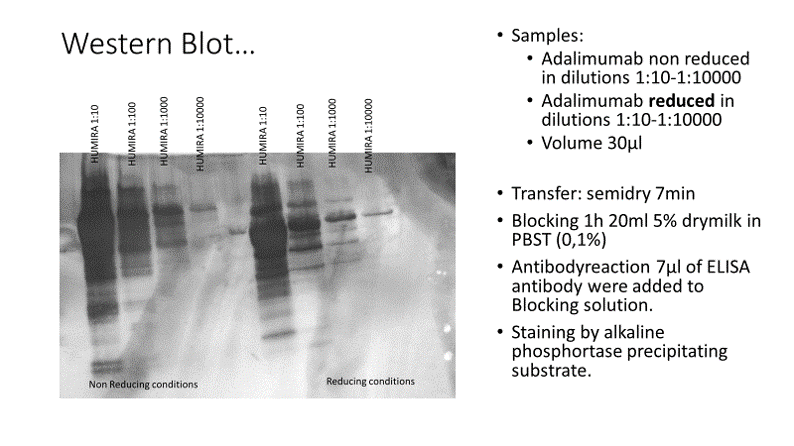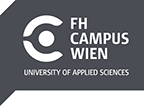Ing. DI (FH) Dr. Harald Kühnel, MSc
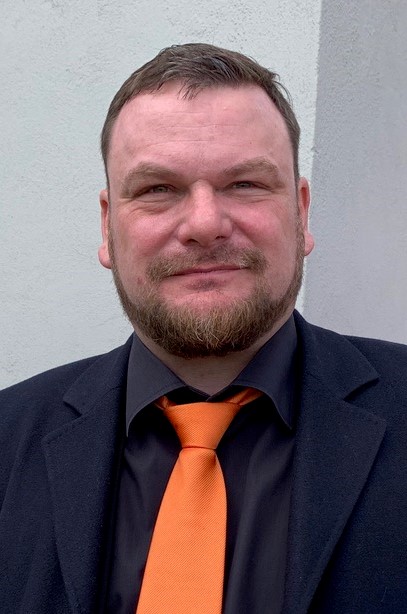
Lehre und Forschung
harald.kuehnel@fh-campuswien.ac.at
+43 1 606 68 77-3603
+43 1 606 68 77-3609
Raum: E.3.04
Favoritenstraße 222
1100 Wien
Lebneslauf (CV):
Professional experience
ORCID ID: https://orcid.org/0000-0002-4780-8061
04.03.2019- now
FH-campus (Bioengineering)
Head of Lab, Lecturer full time, also involved in research and project lead in cooperation withcompanies. Further responsibilities bio process engineering, fermentation, cell-basedassays, bioanalytic, project management, supervision of lab staff and master students
15.01.2018 –01.01.2019
Danube University Krems, center of regenerative medicine
Grant applications, Research projects dealing with blood products and their rejuvenation effects, development of a senolytic therapy for osteoarthritis, implant derived metal ions and development of cellular senescence. Publishing results.
01.11.2009 –01.12.2017
Shire (Baxalta, Baxter Bioscience) Specialty Therapeutics and Antibody Technology, Oncology, department Cell Biology and Gene Therapy
Development of a recombinant AB against MIF, involvement in the whole development of the AB from R&D and pre-clinic to clinic (phase 1 & 2) main responsible person for Biacore analyses.
Tasks: release testing, uncovering the mode of action, assay transfer and implementation, assay development, e.g. Participation in early development and pre-clinic of a gene therapy project.
2007-2009
University of natural resources, institute of applied microbiology (diplomaand doctoral thesis)
Screening experiments with micro-array-technology and related technologies. miRNAs incellular senescence. Invention of a new premature aging model (Polyphenol based) andimplemented several others like H2O2 induced and PUVA. Publishing results.
10.11.1997-31.10.2009
Veterinary university Vienna, Institute of Physiology
DNA-damage detection in cells and animal tissues with methods like HPLC and comet assay. Assay development and implementation. Publishing results.
02.01.1996-23.09.1997
Agency for food-safety
Routine analyses and method development (electrophoresis).
Education
20021-2022 WIFI Wien Ausbildung zum Trainer für Erwachsenenbildung
2009-08.06.2017 Veterinary university Vienna, Institute of Physiology, Doctoral thesis (natural sciences)
„MicroRNAs as markers of cellular senescence”. (Supervision: Prof. Alois Strasser).
2010- 19.10.2012 FH-campus (Bioengineering), Master QM in biotechnology
Thesis: „Effects of isoflurane anesthesia on immune system and DNA integrity “. (supervision: Prof. Johannes Grillari)
2007- 07.07.2008 FH-campus, Certificate: Quality Manager
(supervision: Prof. Rudolf Bliem)
2004- 09.10.2008 FH-campus (Bioengineering), Bio-informatics
Thesis: „Micro RNAs in senescence and after PUVA treatment “. (supervision: Prof. Johannes Grillari) (2005, 2006, 2007 merit scholarship)
1989- 08.06.1994 HTL Rosensteingasse (Biochemistry, microbiology and genetics)
Teaching experience:
13.02.2016 – now FH-campus Bioengineering
lecturer bioanalytical methods molecular biology and cell biology and tutorials and seminars thereof
15.01.2018 –01.01.2019 Danube University Krems
Lecturer bioanalytical methods and genome editing
2007-2009 University of natural resources, institute of applied microbiology
Lab-Meetings und Institutsseminars
10.11.1997-31.10.2009 Veterinary university Vienna, Institute of Physiology
Tutor physiology tutorial Co-supervision of internships diploma and doctoral thesis
Awards:
gifted student award: (2005, 2006, 2007)
Diploma thesis: „Micro RNAs in senescence and after PUVA treatment “. (supervision: Prof. Johannes Grillari)
Master thesis: „Effects of isoflurane anesthesia on immune system and DNA integrity “. (supervision: Prof. Johannes Grillari)
Doctoral thesis „MicroRNAs as markers of cellular senescence”. (supervision: Prof. Alois Strasser).
Awarded in industry: Baxter research and development award
Authorship or technical assistance acknowledged
- Metzger, K.F.J. et al. IGF1 inclusion bodies: a QbD based process approach for efficient
USP as well as early DSP unit operations. Journal of biotechnology (2020). - Metzger, K.F.J., Voloshin, A., Schillinger, H., Kühnel, H. & Maurer, M. Adsorptive
filtration: A case study for early impurity reduction in an Escherichia coli production
process. Biotechnology progress, e2948 (2019). - Thiele, M. et al. Selective Targeting of a Disease-Related Conformational Isoform of
Macrophage Migration Inhibitory Factor Ameliorates Inflammatory Conditions. J
Immunol 195, 2343–2352 (2015). - Douillard, P. et al. Optimization of an Antibody Light Chain Framework Enhances
Expression, Biophysical Properties and Pharmacokinetics. Antibodies 8, 46,
https://www.mdpi.com/2073-4468/8/3/46 (2019). - Dellago, H. et al. High levels of oncomiR-21 contribute to the senescence-induced growth
arrest in normal human cells and its knock-down increases the replicative lifespan. Aging
Cell 12 (2013). - Hackl, M. et al. miR-17, miR-19b, miR-20a, and miR-106a are down-regulated in human
aging. Aging Cell 9, 291–296 (2010). - Reynoso, R. et al. HIV-1 induces telomerase activity in monocyte-derived macrophages,
possibly safeguarding one of its reservoirs. Journal of Virology 86 (2012). - Ablimit, A., Kühnel, H., Strasser, A. & Upur, H. Abnormal Savda syndrome: Long-term
consequences of emotional and physical stress on endocrine and immune activities in an
animal model. Chinese Journal of Integrative Medicine 19 (2013). - Kühnel, H. et al. Investigations into cytotoxic effects of the herbal preparation Abnormal
Savda Munziq. Chinese Journal of Integrative Medicine,
http://www.ncbi.nlm.nih.gov/pubmed/25967604 (2015). - Strasser, A., Kuhnel, H., Velde, K. & Dadak, A. Immunomodulation during and after
castration under inhalation anaesthetic without genotoxic effects on equine lymphocytes.
Research in veterinary science (2011). - Kankofer, M. & Schmerold, I. Spontaneous oxidative DNA damage in bovine retained and
nonretained placental membranes. Theriogenology 57, 1929–1938 (2002). - Lopucki, M. et al. Low dose magnetic fields do not cause oxidative DNA damage in
human placental cotyledons in vitro. Virchows Archiv : an international journal of
pathology 446, 634–639 (2005). - Schmerold, I. & Niedermuller, H. Levels of 8-hydroxy-2’-deoxyguanosine in cellular
DNA from 12 tissues of young and old Sprague-Dawley rats. Experimental gerontology
36, 1375–1386 (2001). - Wiktor, H. et al. Oxidative DNA damage in placentas from normal and pre-eclamptic
pregnancies. Virchows Archiv -1, 1, http://dx.doi.org/10.1007/s00428-004-1024-2 (2003).
Arbeitgeber und erlernte Techniken
FH-Campus Wien Arbeiten mit Microcarriern, Molekularbiologie e. coli, Hefen und Säugetier Zellen, Fermentationen, HPLC (Thermo), Toxizitäts Tesungen, Sequenzierung mittels Oxford Nanopore, …..
Donau Universität Krems Flow Cytometrie, XTT Assays, Casp 3/7 Assays, Fluoreszenzmiroskopie, IC, SA-ß-Gal staining, qPCR, ….
Shire (Baxalta, Baxter Bioscience) Proteinanalytik und Aufreinigung: Expression von Proteinen in Bakterien, Proteinextraktionen, 2D Elektrophorese, Western Blot Analysen, Immuno (und Co-Immuno) Präzipitation, ELISA, SPR (Biacore), Protein-Aktivitäts-Assays, (IC, SEC, RP, Affinitäts)-FPLC (Äkta) und HPLC (floureszenz und PDA-Detektion) (chemStation) Zellkultur: Gewinnung von primären Zellen, Chemotaxis-assays, Xcelligence, Floureszenzmikroskopie, IHC, Definiens
Tissue Studio®, FACS-Analysen Virologie: rcAAV-assay, DNA-Extraktionen, q-PCR-Analysen, molekularbiologische Arbeiten (PCR, Elektrophoresen, …), IHC, Extraktion und Analyse von Exosomen, durchführen von release Testungen, ….
Universität für Bodenkultur Zellkultur (Zelllinien und primäre Zellkultur), q-PCR, TaqMan Analysen, microArray Analysen, Bioanalyzer, Elektrophorese-Techniken, Färbetechniken
Veterinärmedizinische Universität Wien Methoden, Assay-Implementierung und Entwicklung, RP-HPLC-Analysen (ECD und PDA-Detektion (Waters)), UV/Vis-Spektroskopie, Extraktion von DNA/ RNA mittels verschiedener Techniken aus Geweben und Zellen.
Proteinbestimmungen, Zellkultur (Zelllinien und primäre Zellkultur), Einzelzellen-Elektrophorese (Comet-Assay), computerunterstützte statistische Auswertung von Analyseergebnissen und Versuchsreihen, Proliferations-Assays (Thymidin Einbau), Instandhaltung der Laborgeräte, wissenschaftliche Literatursuche, Labor Organisation
Bundesanstalt für Lebensmitteluntersuchung Wien Analyse der Zusammensetzung von Wurstwaren mittels Elisa, Ochratoxin A Nachweis in Kaffee und Mehlproben mittels Elisa, Radiale Immundiffusion, Disk SDS-PAGE von Käseproben zur Bestimmung der Zusammensetzung (qualitativ und quantitativ), Iso-elektrische Fokussierung
Web Pages:
https://www.researchgate.net/profile/Harald_Kuehnel
https://scholar.google.at/citations?user=dmk0xUkAAAAJ&hl=de
https://www.vetmeduni.ac.at/de/physiologie-und-pathophysiologie/about-us/staff/alumni/
https://www.linkedin.com/in/harald-k-848b165b/
https://orcid.org/0000-0002-4780-8061
Sonstiges:
Programmiersprachen: Grundkenntnisse von Perl, Java, C, mySQL
Software: GraphPadPrism, Minitab, SPSS, Excell, Word, Powerpoint,
Kurse und Fortbildungen:
Genome Editing und NGS (Lab Academy), Flow Cytometrie Kurs (AKH Wien) – Basiskurs Molekularbiologie (Elsevier GmbH Spektrum Akademischer Verlag) – PCR Basis und Fortgeschrittenenkurs, RT-PCR Kurs (Eppendorf) – qPCR-Kurs (Biorad)- Biacore Schulungen (GE-healthcare) – HPLC (Agilent chem-station und Waters Empower und Millenium) – Floureszenzmikroskopie (Olympus); Definiens Tissue Studio® Training
Sonstige Erfahrungen: HTL Spengergasse (Abendschule) 3 Semester (Informatik), Studium Universität Wien: Genetik 3 Semester, Lebens und Sozialberater (Systemische Therapie) 2 Semester, Universität für Bodenkultur Master Biotechnologie 1 Semester NLP-Seminare.
Privat: Jugendsport: Handball (Vizestaatsmeister und Staatsmeister)
Freizeit: geprüfter Barista, Wandern, Lesen,
Beispiele für Master und Bachelor Arbeiten im FH-Labor von mir betreut:
Zsolt Véghelyi (Verfasser der Diplomarbeit und des folgenden Abstracts )
„Cellular senescence and polyphenols“
“Natural compounds in senolytic therapy”
Abstract
Since human’s average lifespan gets higher, we observe various age-related diseases that need to be cured. Some of them are associated to senescent cells accumulating in our tissues with age. Senescent cells differ from proliferating cells by numerous inherent properties such as secretion of inflammatory signals, resistance to certain apoptosis pathways or accumulation of damaged proteins. Protein homeostasis is important for a cell and accumulation of damaged proteins can induce apoptosis by unfolded protein response. This leads to the hypothesis that the inhibition of the proteasome, or chaperones involved in protein homeostasis, are potential targets to remove senescent cells selectively. Hsp90 inhibitors have been recently discovered as a new class of senolytics. Some of them are naturally occurring polyphenols such as quercetin. Several other natural compounds, as a potential treatment for age related diseases, are also in focus of current research. Green Tea is rich in polyphenols and its antioxidant properties are reported to have health beneficial effects, suggesting it to be a potential candidate in senotherapy. We hypothesized that natural polyphenolic extracts could have a beneficial add-on effect to classic senotherapy. To investigate the effects of polyphenols, in combination with the established drugs 17´DMAG, Bortezomib and Tunicamycin, a model organism is needed. We used Human Dermal Fibroblasts HDF164 as a model organism and two different ways of senescence induction were performed (i.e., Etoposide and CuSO4). Dose response studies were performed to evaluate the cytotoxic effects of the drugs. Senolytic effects were tested in dose response studies and by performing combination treatments in multi-well plates followed by SA-ß-Gal staining. Also, the effects of the treatments on the cells secretome and the protein ubiquitination were investigated. Senescence induction by either Etoposide or CuSO4 leads to senescent cells which distinguish in their percentage of SA-ß-Gal positive cells as well as in their SASP levels. We found that the senolytic 17´DMAG is inhibited by green tea extract in combination treatments. Senolytic properties of Quercetin could not be verified in our models. A combination of green tea and Tunicamycin seems to have beneficial effects on SASP levels. The results indicate that the combination of natural compounds and established drugs show interactions that may have negative therapeutic effects. These interaction effects should therefore be considered during the therapy. The need for reliable senotherapeutics is clearly present and will increase over the next years.
Entwicklung einer Methode zur Überwachung des Zustands von Zellen in Microcarrier-basierenden Bioprozessen
Bachelorstudent: Leon König
Die Kultivierung von adhärenten tierischen Zellkulturen erfolgt meist als Monolayerkulturen in Rollerflaschen oder auf sphärischen Partikeln, den Microcarriern. Die Bestimmung von Zuständen, wie der Viabilität oder Apoptoserate dieser Zellen stellt dabei eine herausfordernde Aufgabe dar und kann nicht mit üblichen Methoden wie einer Trypanblaufärbung durchgeführt werden. Um diese Zustände einer lebenden Kultur bestimmen zu können werden in dieser Arbeit verschiedene Fluoreszenzfarbstoffe verwendet. Die Fluoreszenzfarbstoffe sind in der Lage Zellen mit bestimmten Eigenschaften anzufärben. Zur Informationserfassung von Zellen, die auf Microcarriern wachsen werden Aufnahmen mit einem Fluoreszenzmikroskop gemacht. Die anschließende automatisierte Zellzählung wird mit dem kostenlosen Bildbearbeitungsprogramm mit ImageJ durchgeführt. Es werden die Vorteile und Nachteile einiger gängiger Fluoreszenzfarbstoffe besprochen und ein geeignetes Färbeprotokoll entwickelt für die Färbung von Zellen in Suspension und auf Microcarriern. Für die Auswertung mit Image wurden viele verschiedenen Messeinstellungen getestet, für die Entwicklung einer schnellen, automatischen und zuverlässigen Zählmethode.
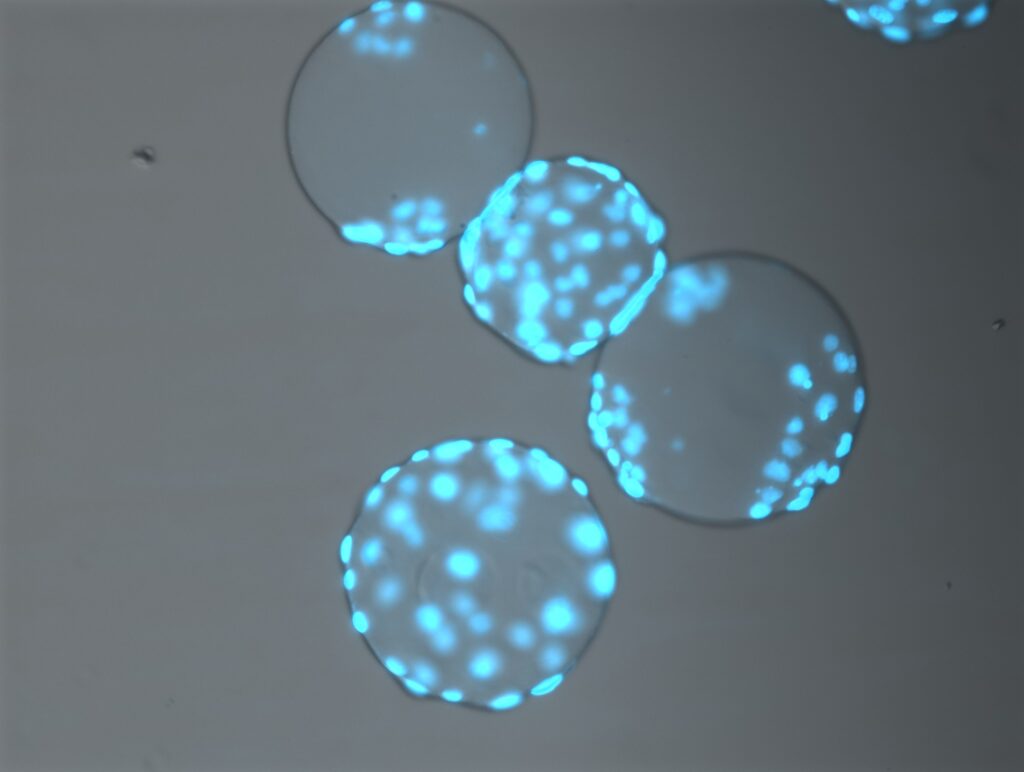
The cultivation of adherent mammalian cell cultures mostly happens as monolayer cultures in roller bottles or cultivated on spherical particles, the microcarrier. The accurate determination of different states of these cells like viability or apoptotic rate is a challenging task and cannot be performed by common methods like trypanblue staining. In order to determine these states of cells, this work will make use of various fluorescent dyes. These dyes are capable of staining cells according to certain properties. For the acquisition of these information of cells growing on microcarriers, we will take pictures with a fluorescence microscope. The subsequent automated cell counting will be performed with the complimentary image processing program ImageJ. We discuss advantages and disadvantages of common fluorescent dyes and try to develop an appropriate protocol to stain cells in suspension and on microcarriers. For
the analysis with ImageJ, we test a great number of different settings to develop a fast, automatic und reliable counting method.
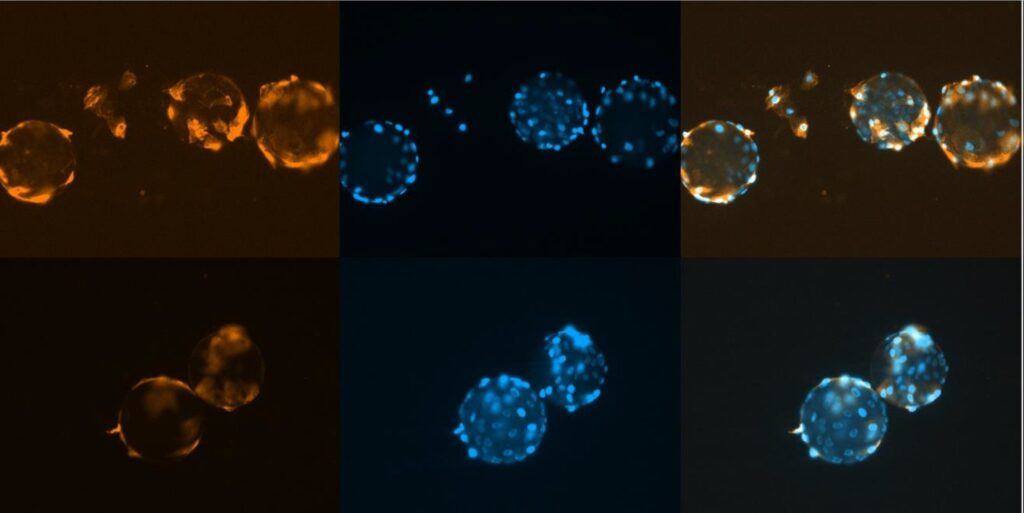
Impressionen aus dem Labor:
Projekte im Labor (Praktika,….)
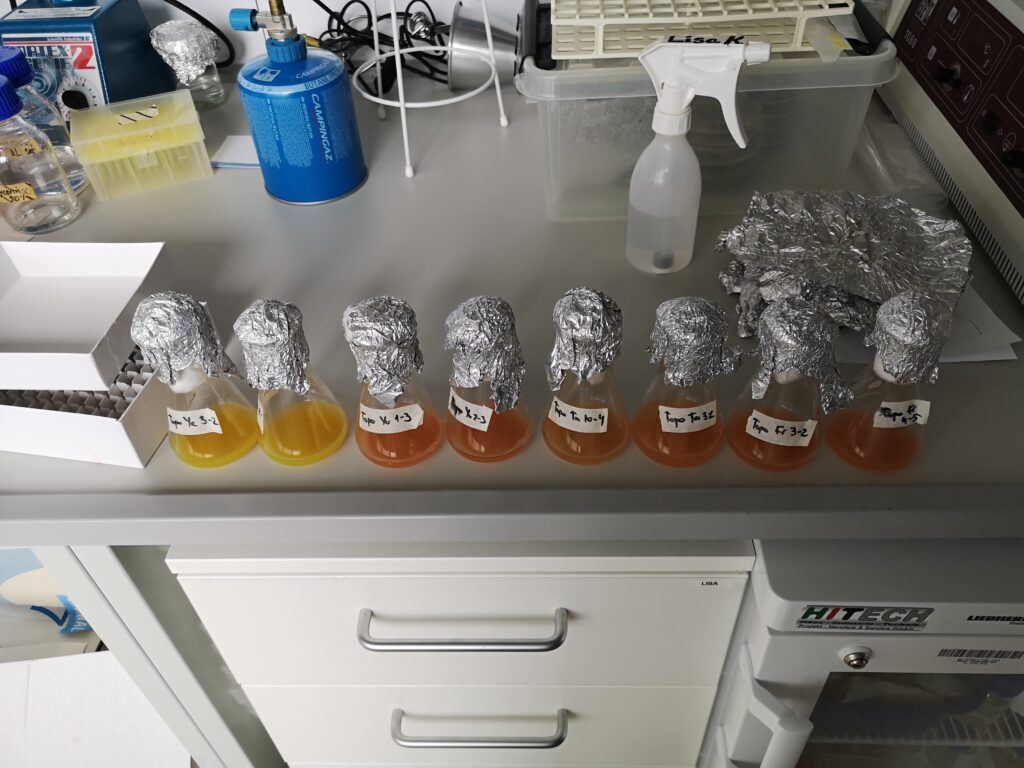
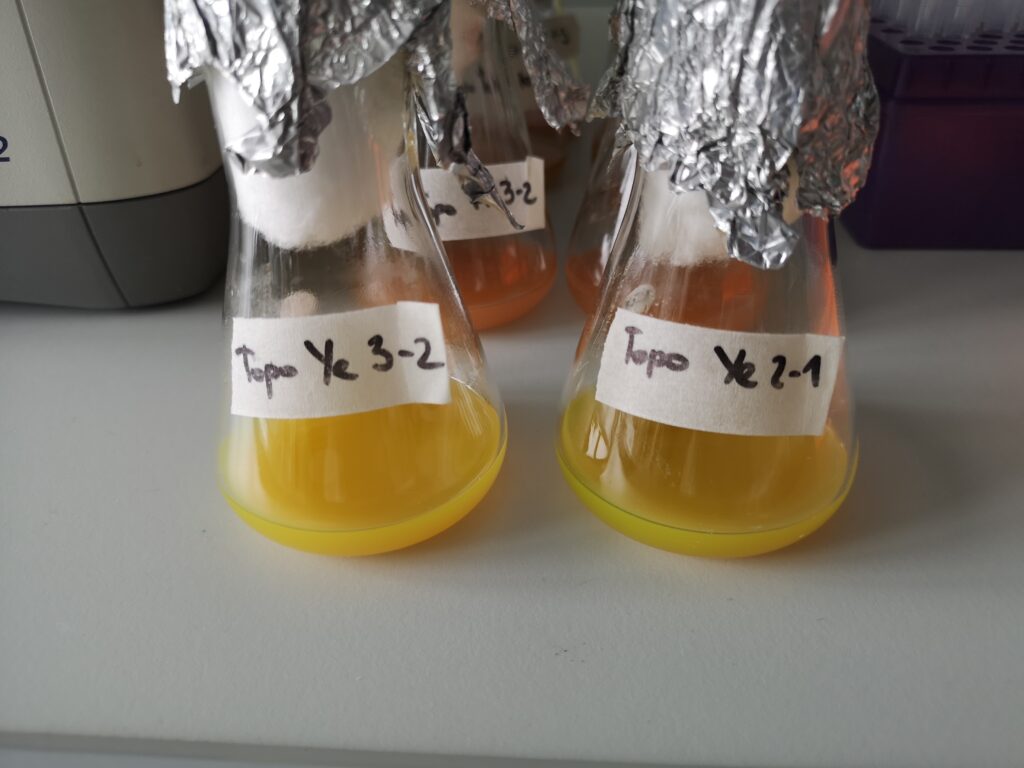
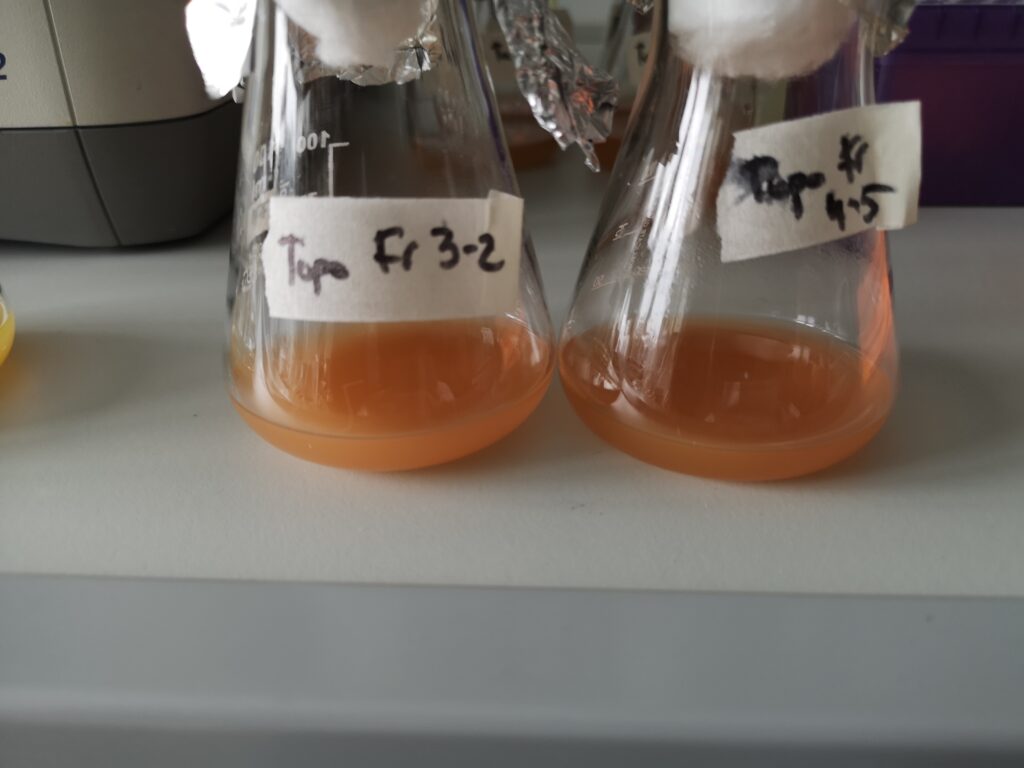
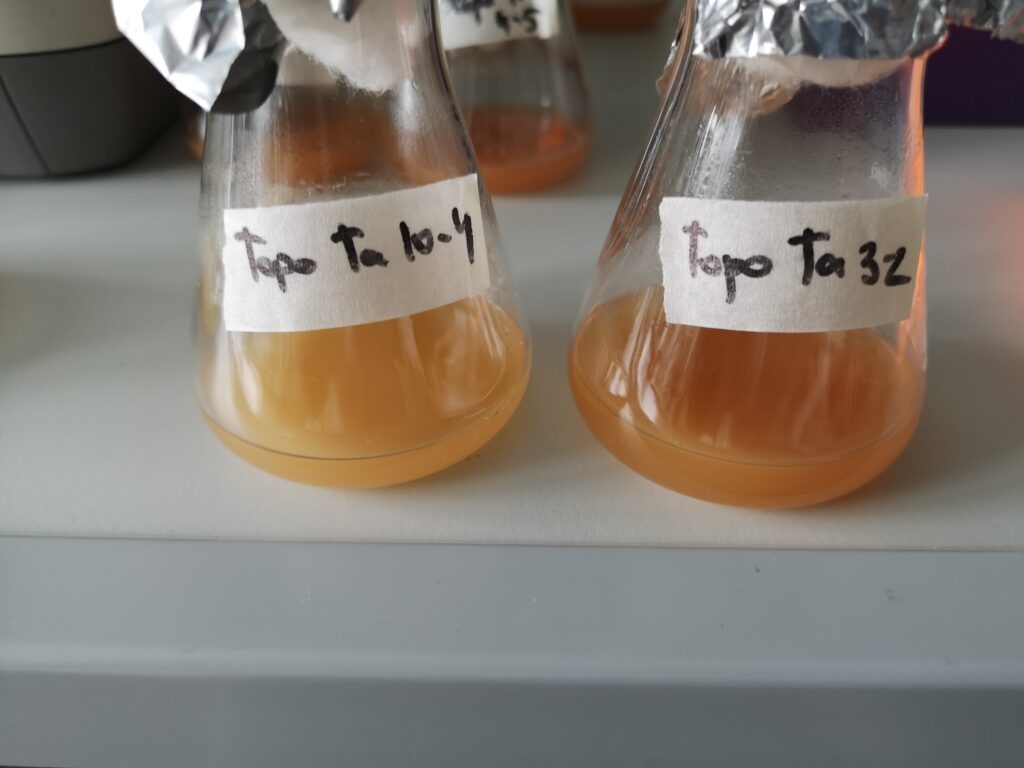
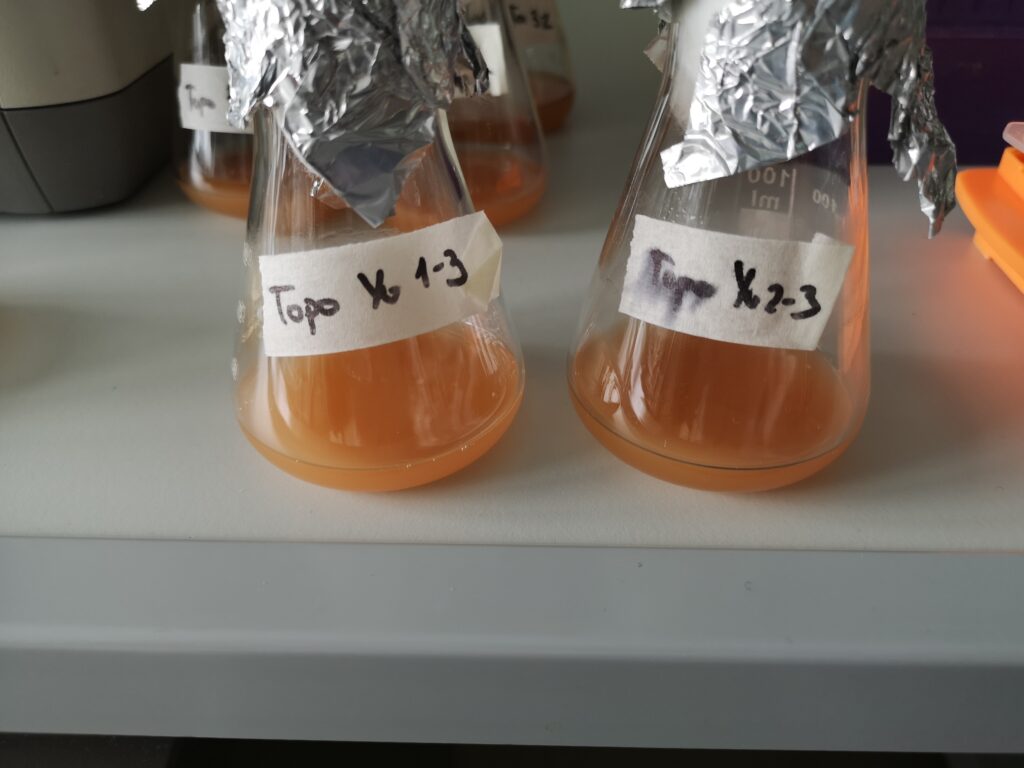
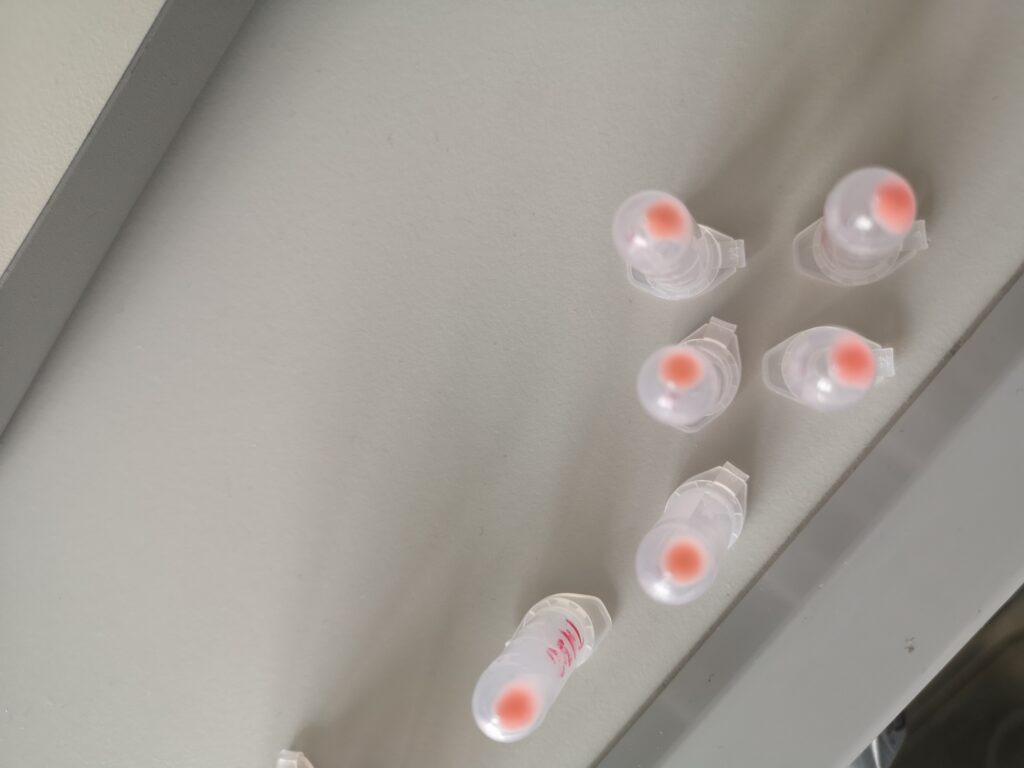
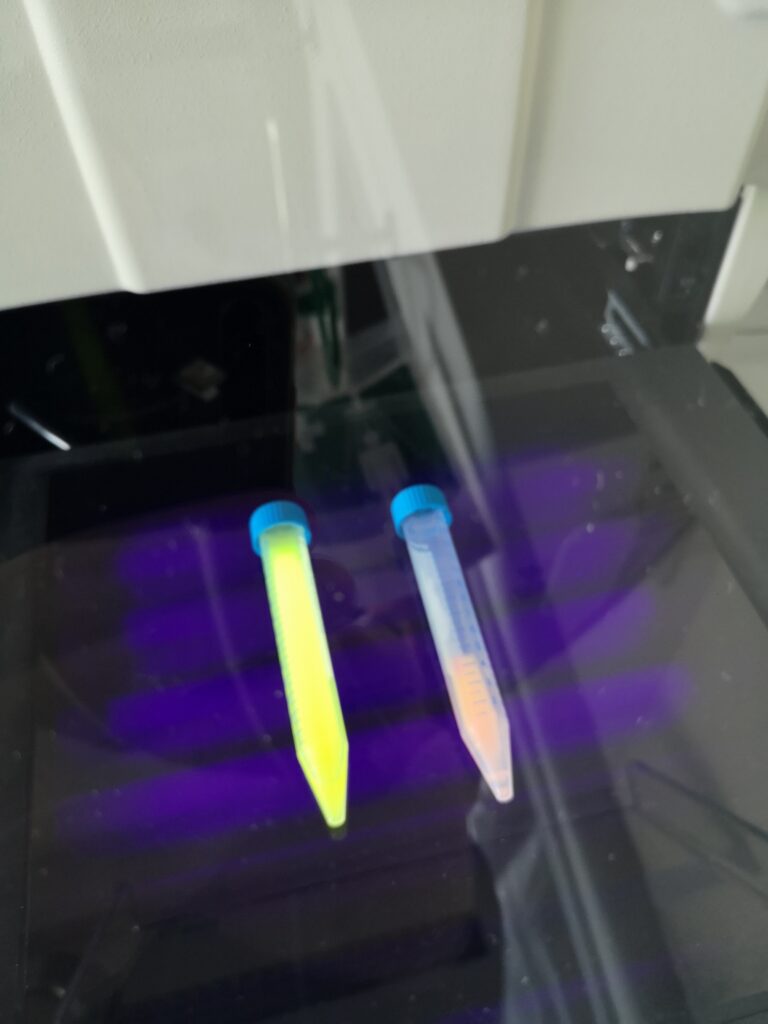
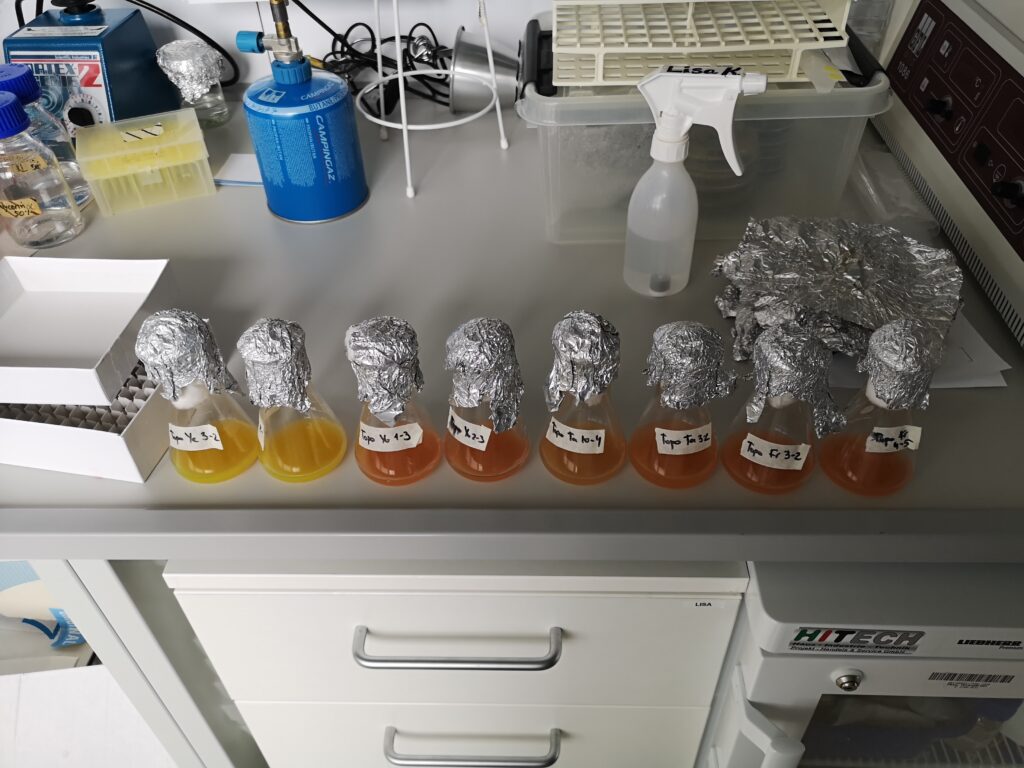
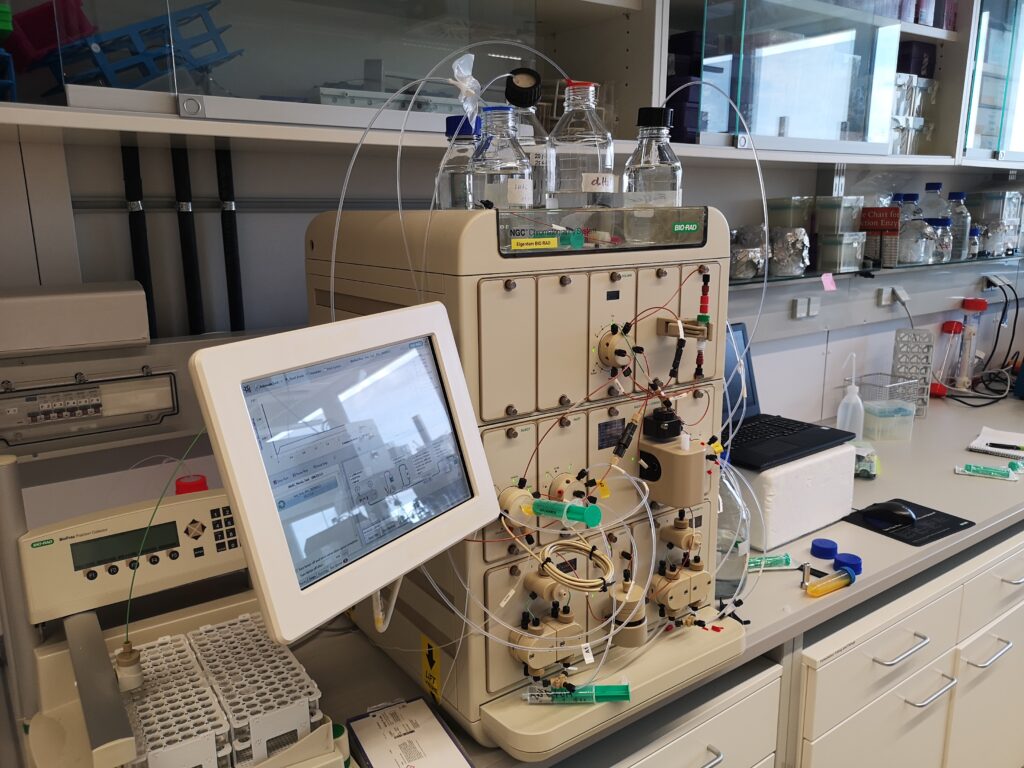
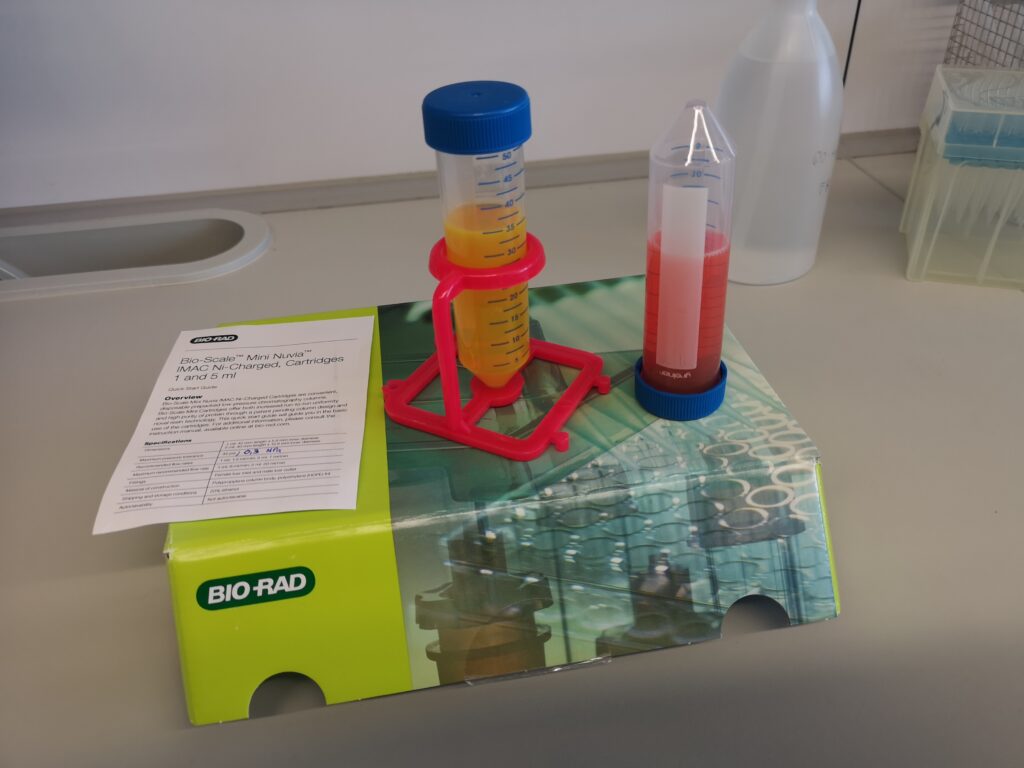
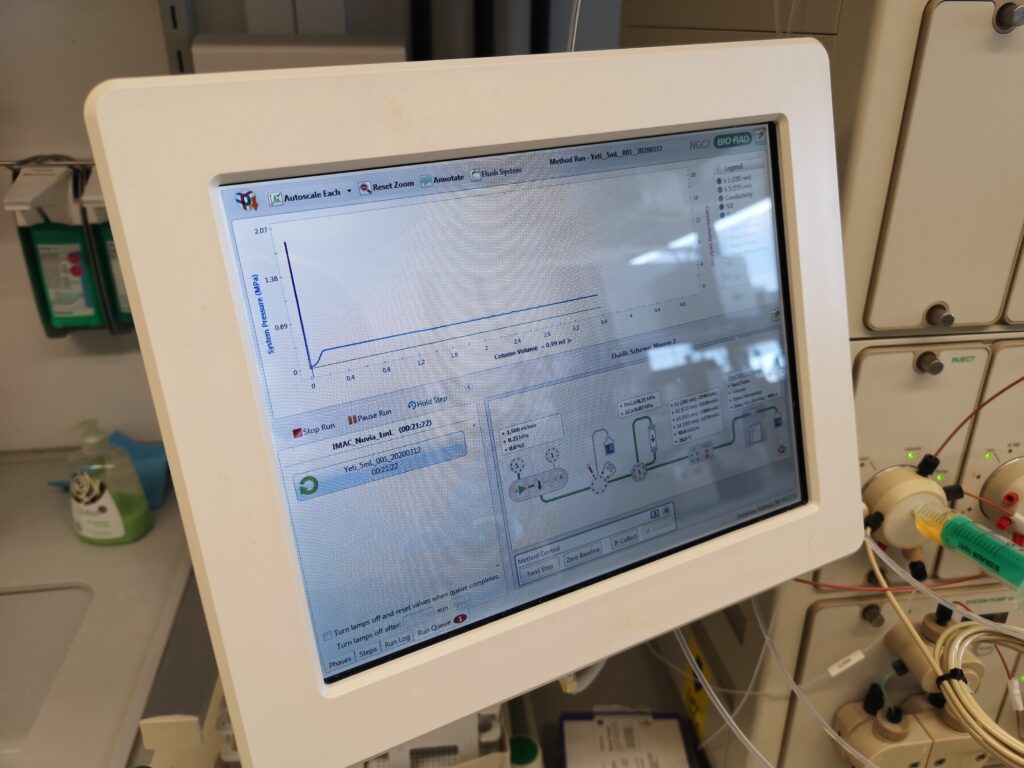
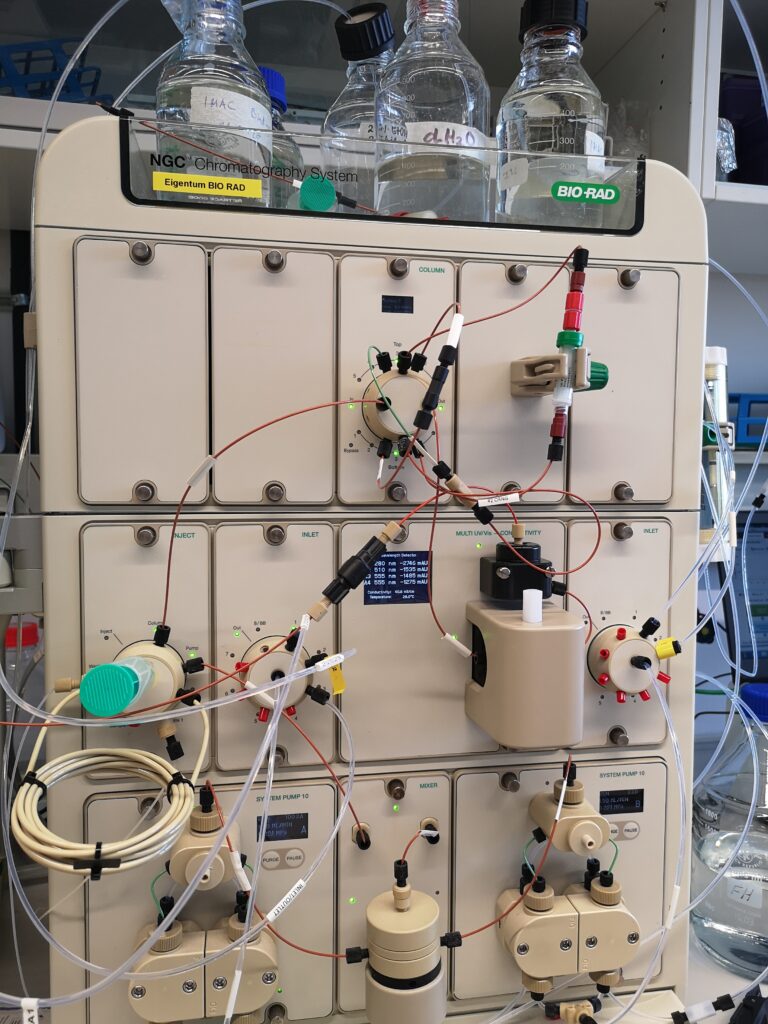
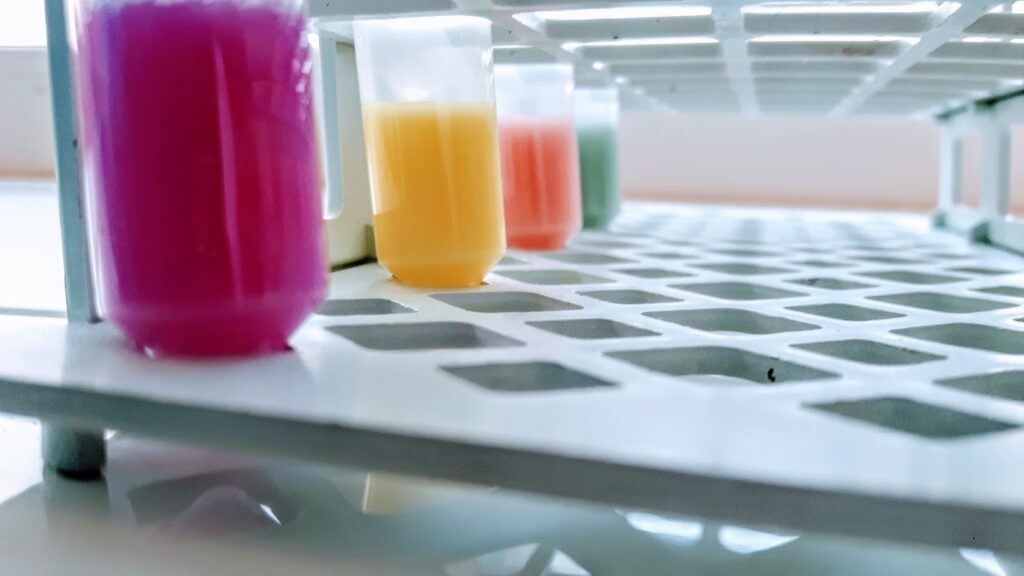
Foto: K. Seiberl 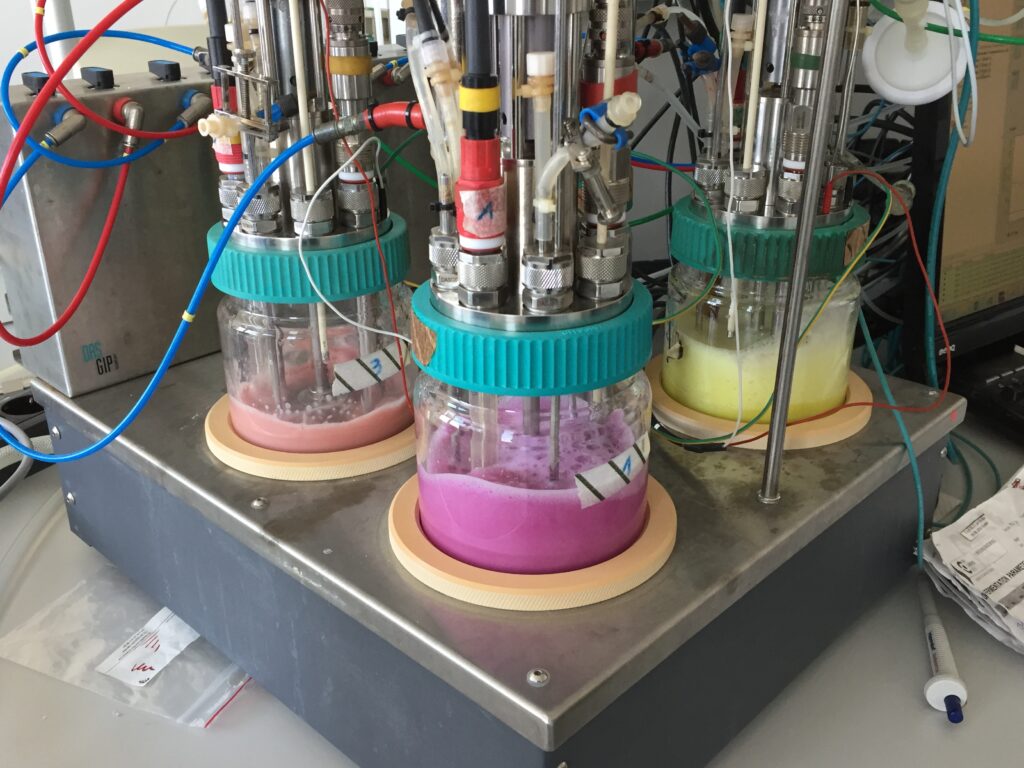
Foto: K. Seiberl 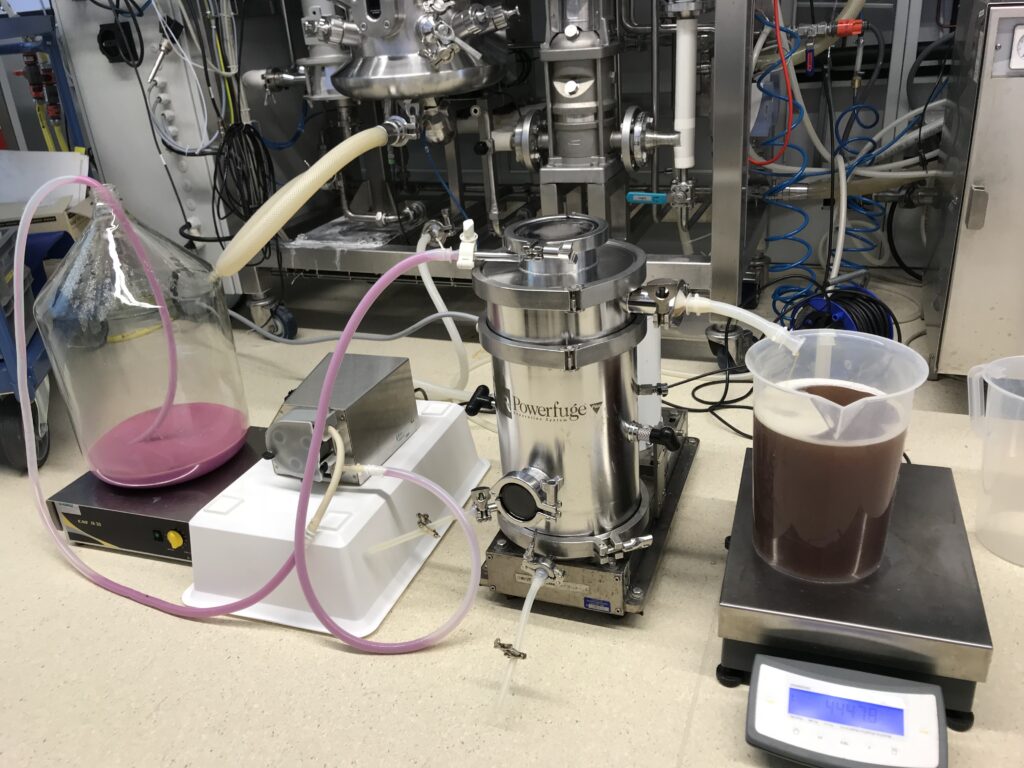
Foto: K. Seiberl
Die Proteine wurden von Student*innen kloniert und exprimiert und aufgereinigt mittels HIS-Tag-IMAC Chromatographie und wir werden die produzierenden e. colis für die Übungen einsetzen….
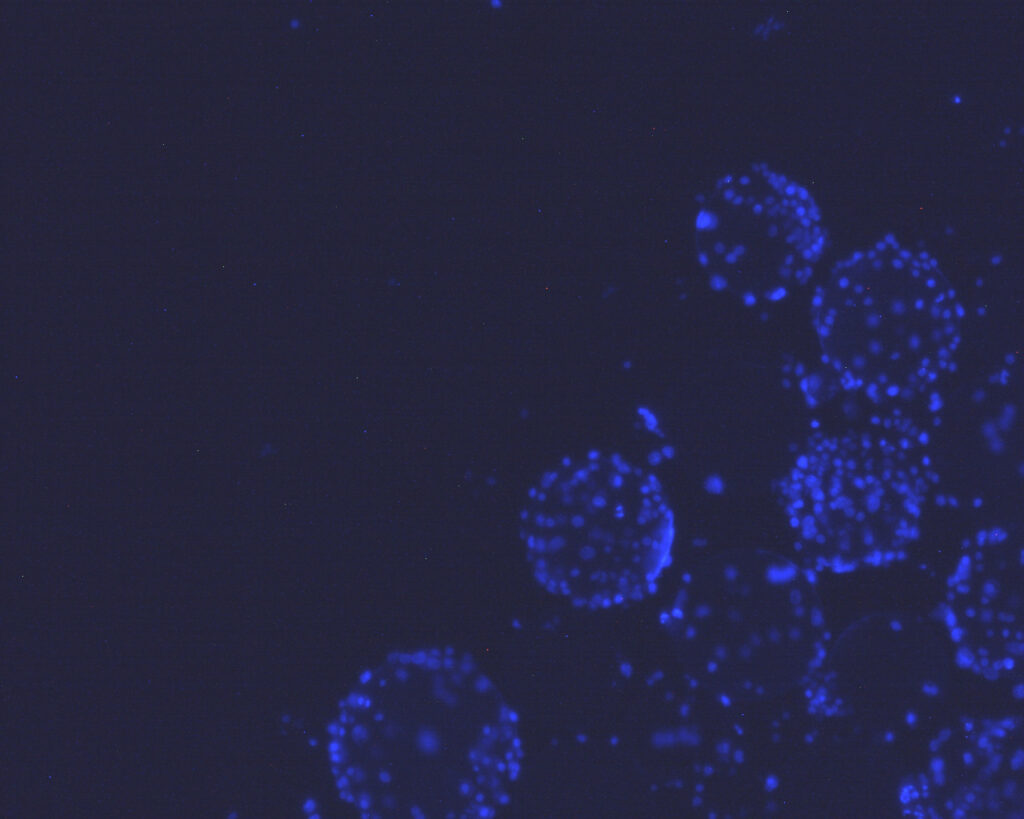
DAPI gefärbte Zellen auf Microcarriern 
Zellen auf Microcarriern (Foto Josef Lienharter) 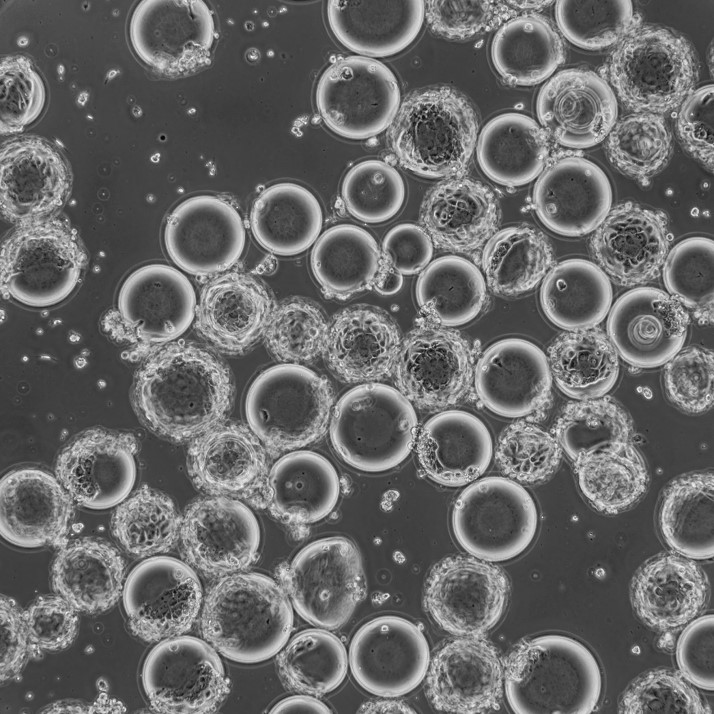
Zellen auf Microcarriern (Foto Josef Lienharter) 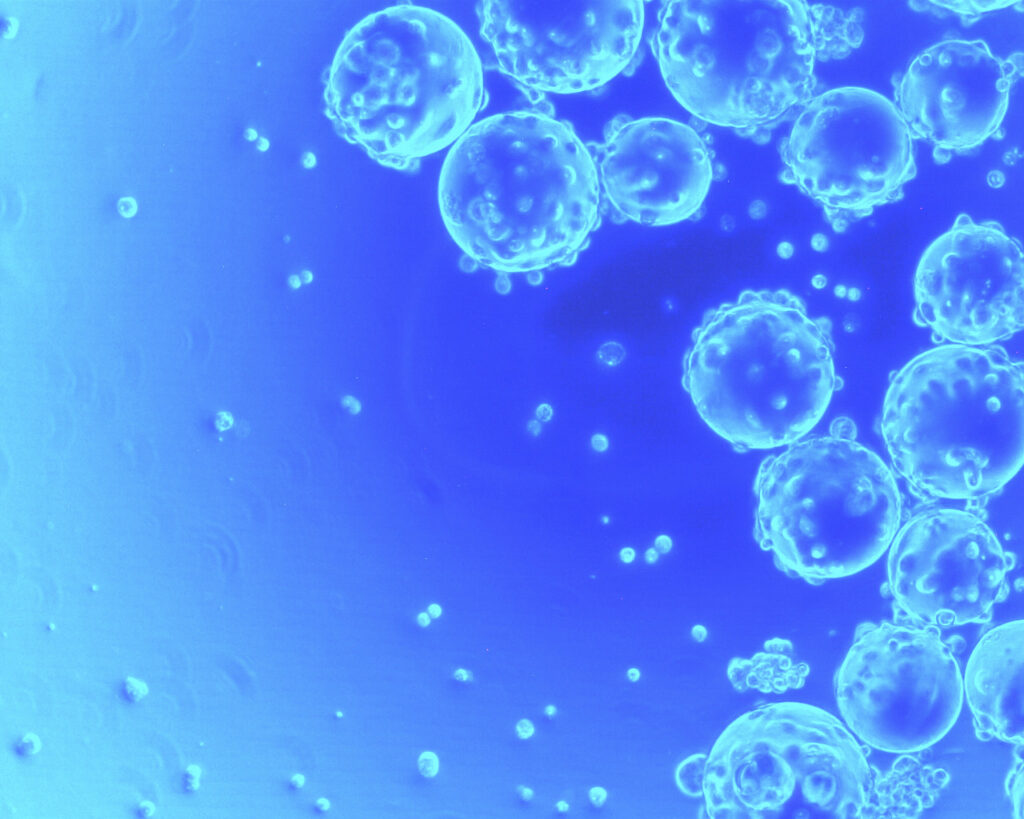
CRFK-Zellen auf MC 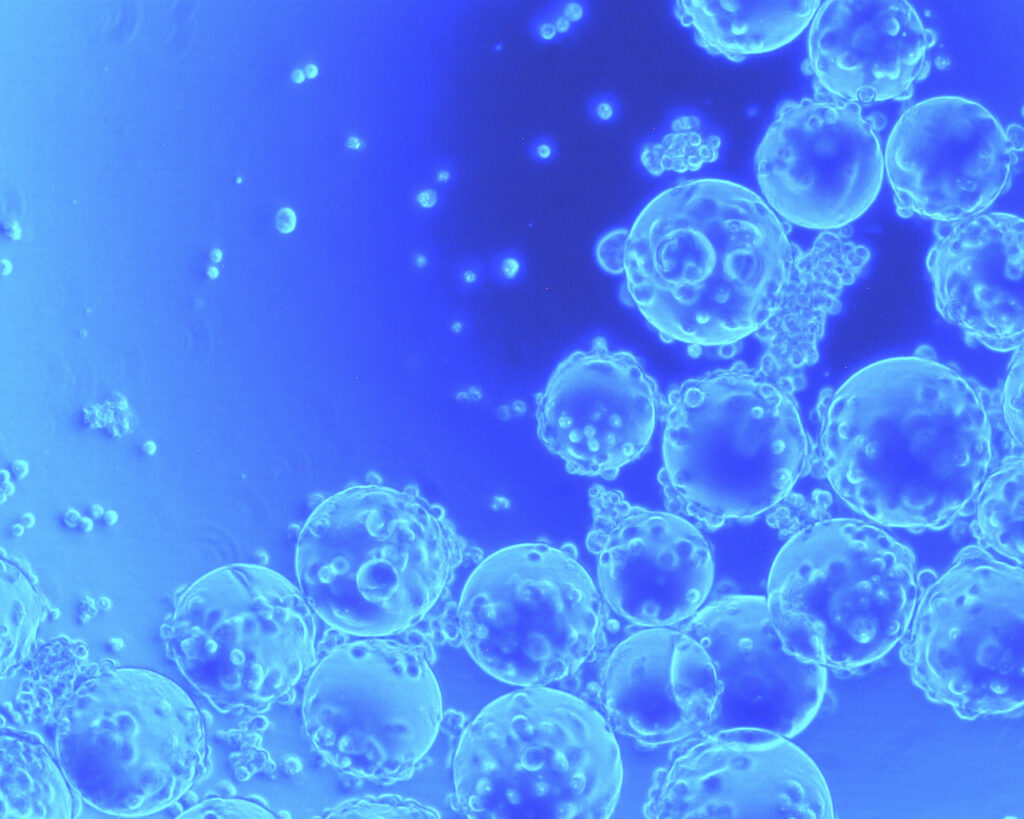
CRFK-Zellen auf Microcarriern
Student*innen haben versucht ein Programm zu schreiben mit dem man DAPI gefärbte Zellkerne auf Microcarriern zählen kann….
Praktikum: 16s rRNA universal bacterial qPCR
Autor: Maximilian Potzel
Abstract
In Zellkultur Laboren in denen vornehmlich mit tierischen Zellen gearbeitet wird, stellen bakterielle Kontaminationen aufgrund der schnelleren Wachstumsgeschwindigkeit, im Vergleich zu tierischen Zelllinien, eine sehr hohe Quelle für das Scheitern von Experimenten dar. Zwar gibt es verschiedene Möglichkeiten Zelllinien und Medien auf bakterielle Zellen überprüfen zu können, wie die Sequenzierung in einem entsprechenden Labor oder das Ausstreichen auf Nährmedienplatten und anschließende Beobachtung auf potenzielles Wachstum. Allerdings besteht der Bedarf an einer Methode, welche schnell, günstig sowie, mit vorhandenem Laborequipment, einfach durchzuführen ist, aber trotzdem ausreichend sensitive und spezifische Ergebnisse liefert. Hierzu wurde versucht einen Teil der ribosomalen 16s RNA zu amplifizieren, da dieses Gen hoch konserviert in vielen verschieden Bakterienspezies vorliegt. Im folgenden Text wird der Versuch der Entwicklung einer entsprechenden qPCR-Methode beschrieben, welche alle bakterielle DNA gleichermaßen qualitativ und quantitav nachweisen kann.
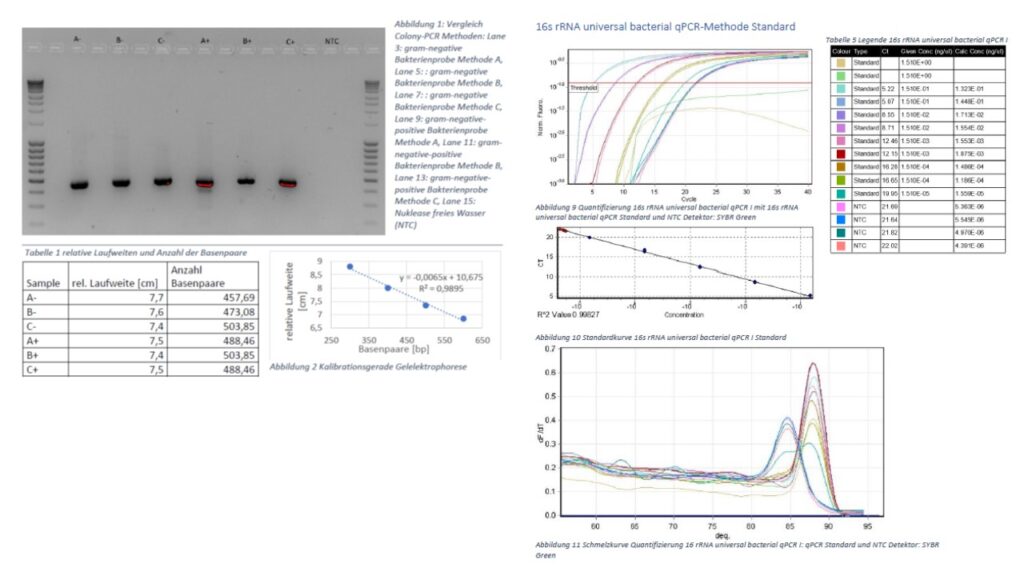
Praktikum:
Durchführung von IL-6 ELISA Bestimmungen für die Altersforschung. Student*innen haben die Konzentration von IL-6 (einem inflammatorischen Cytokin) in Zellkulturüberständen von seneszenten Zellen gemessen die mit Pflanzenextrakten und natürlichen Substanzen behandelt wurden.
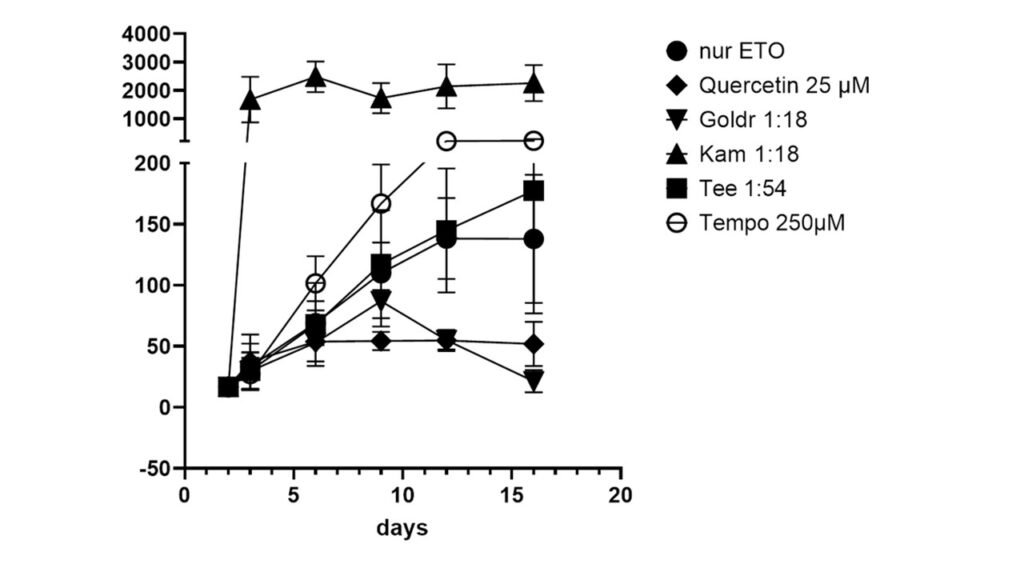
Ausstattung des Labors:
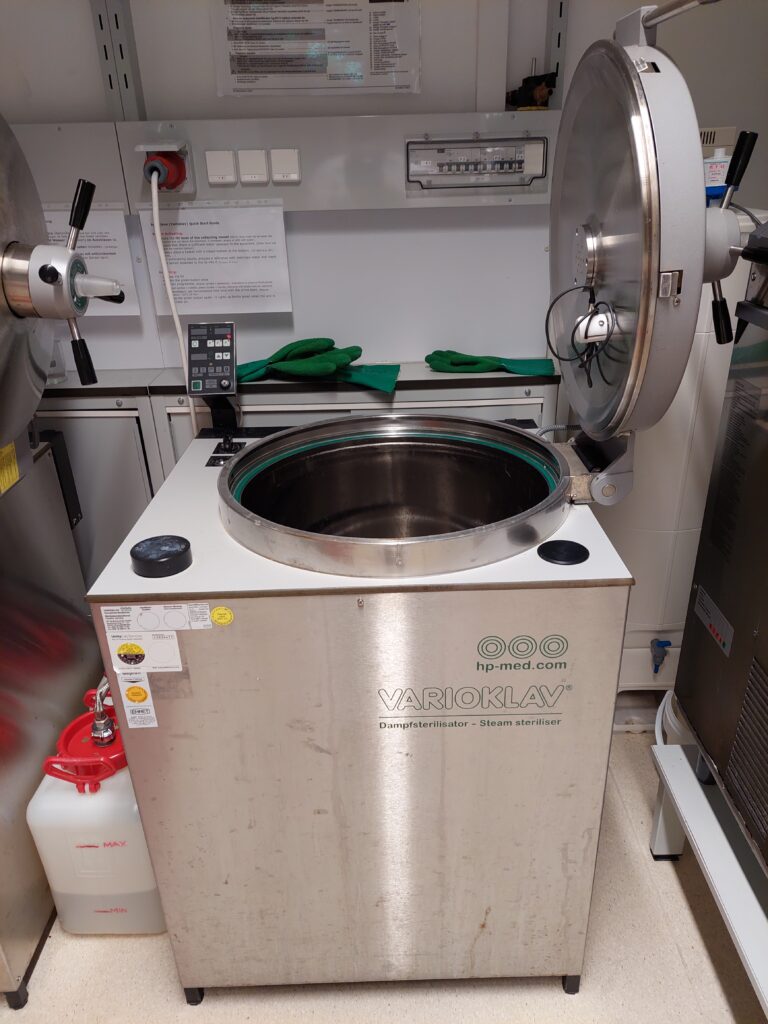
Autoklav 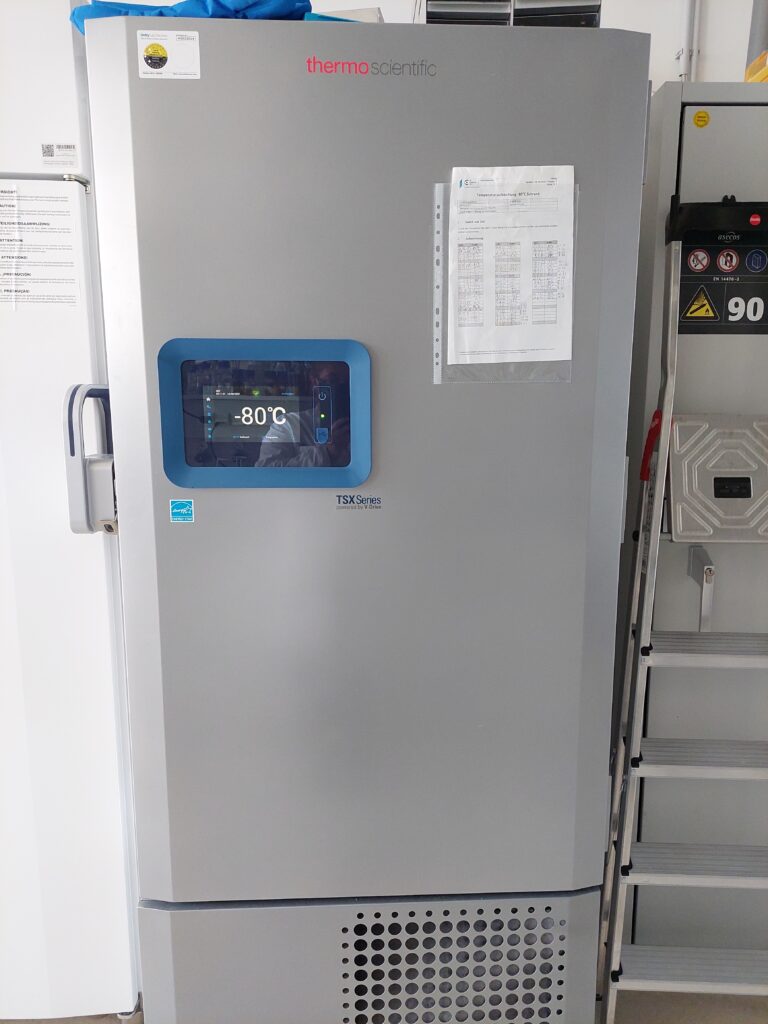
-80°C Schrank 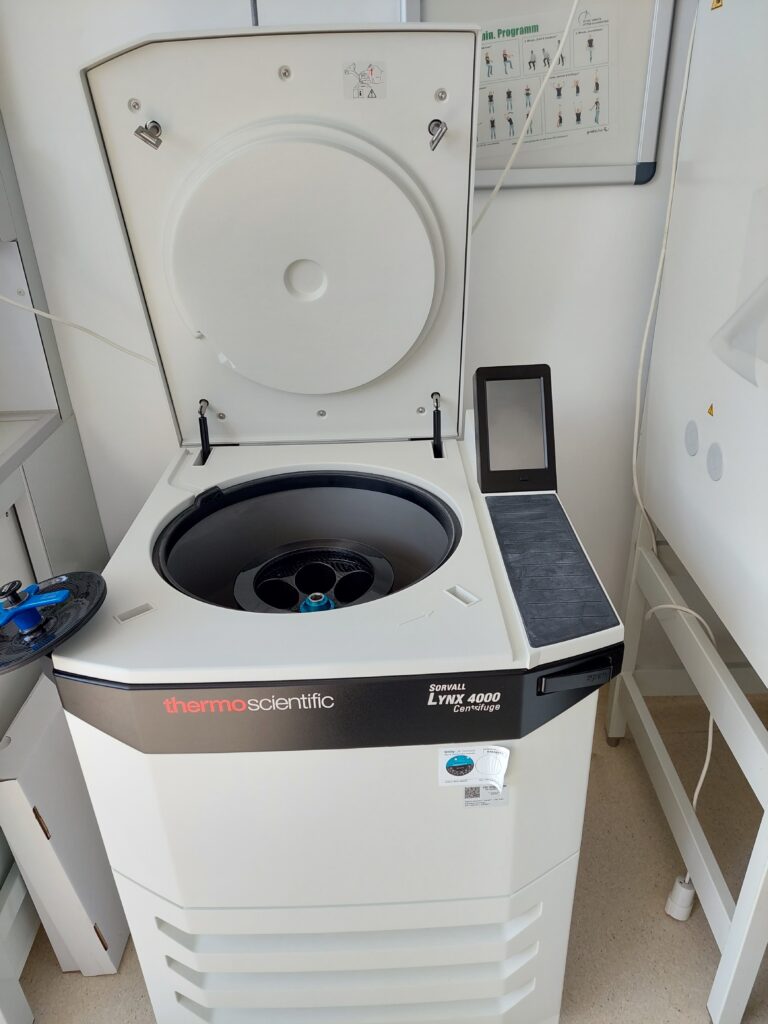
große Zentrifuge 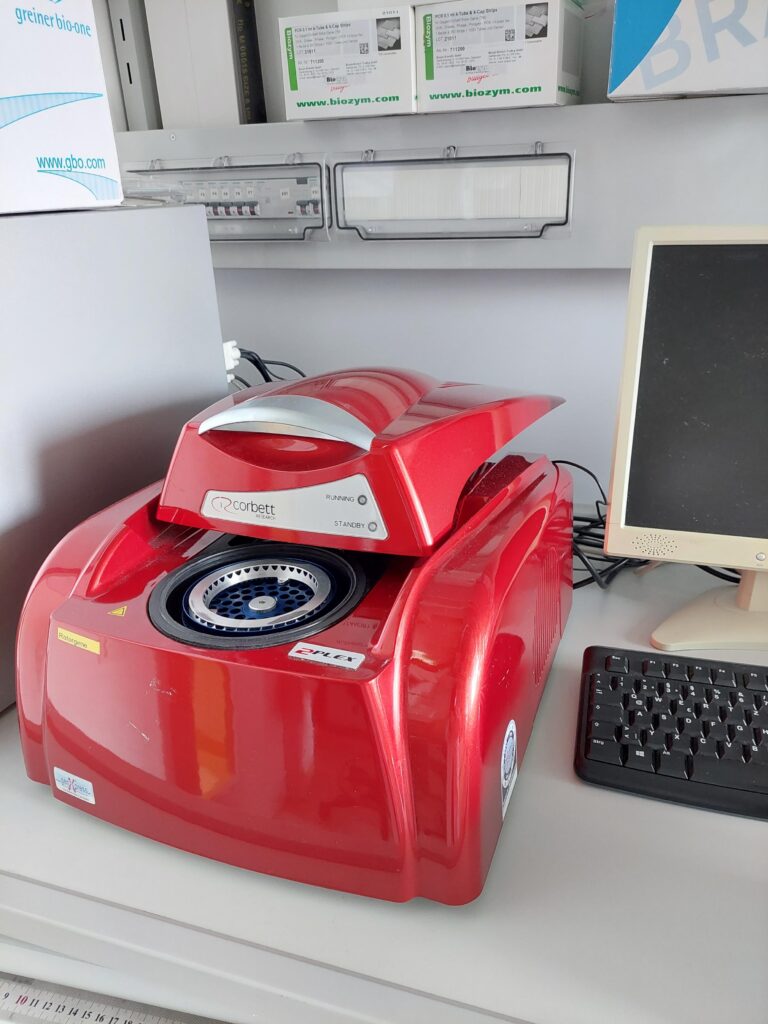
qPCR 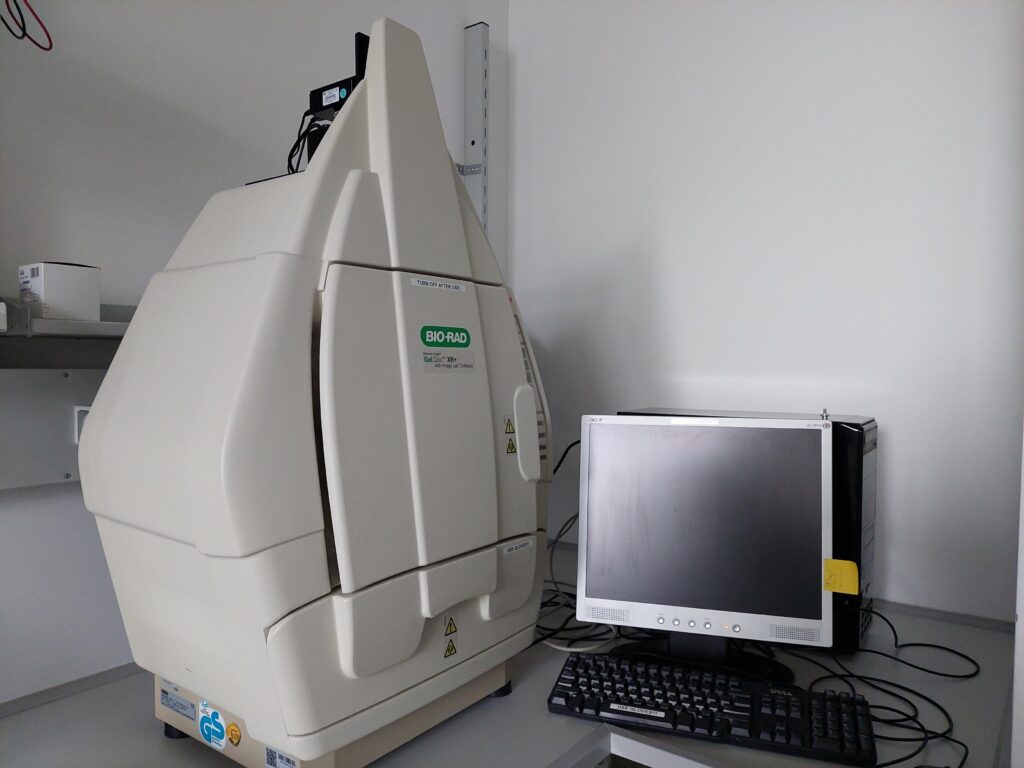
Imager 
UPLC Detektoren UV-Vis und Brechungsindex 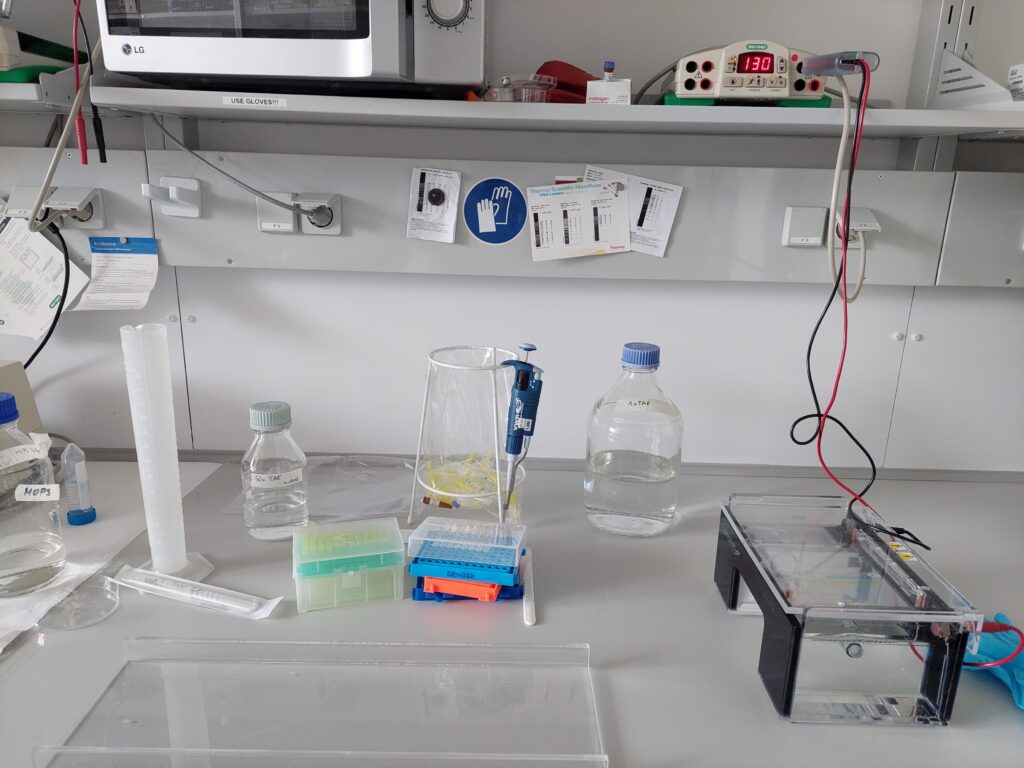
Platz für Gelelektrophoresen 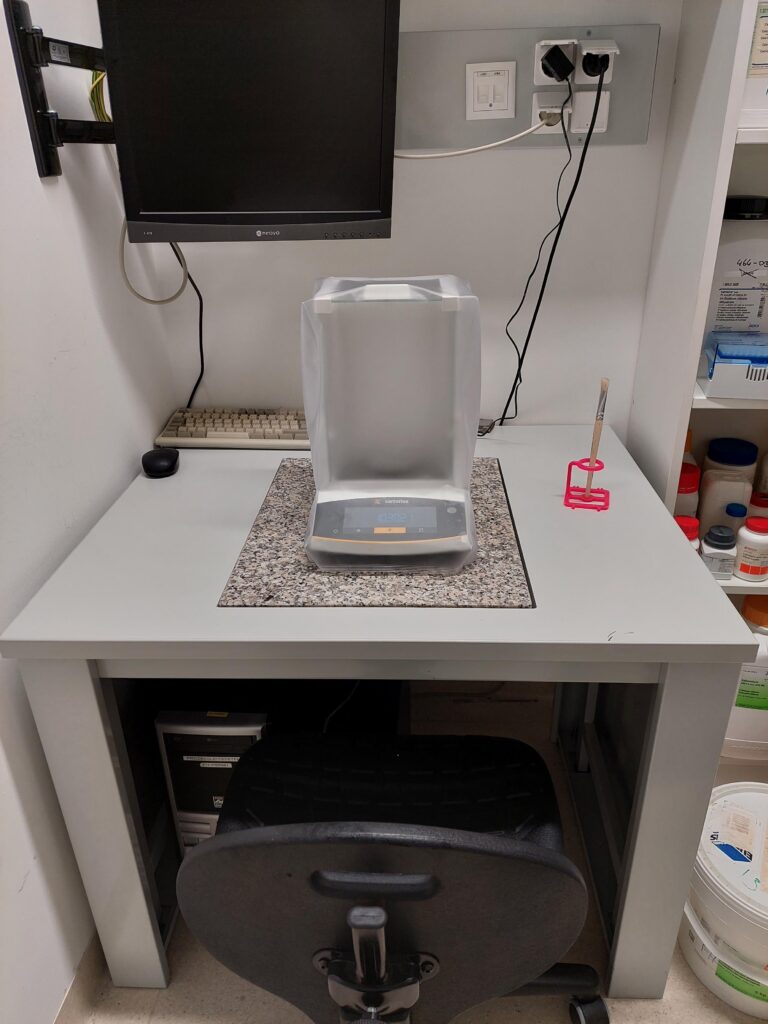
Wägeplatz 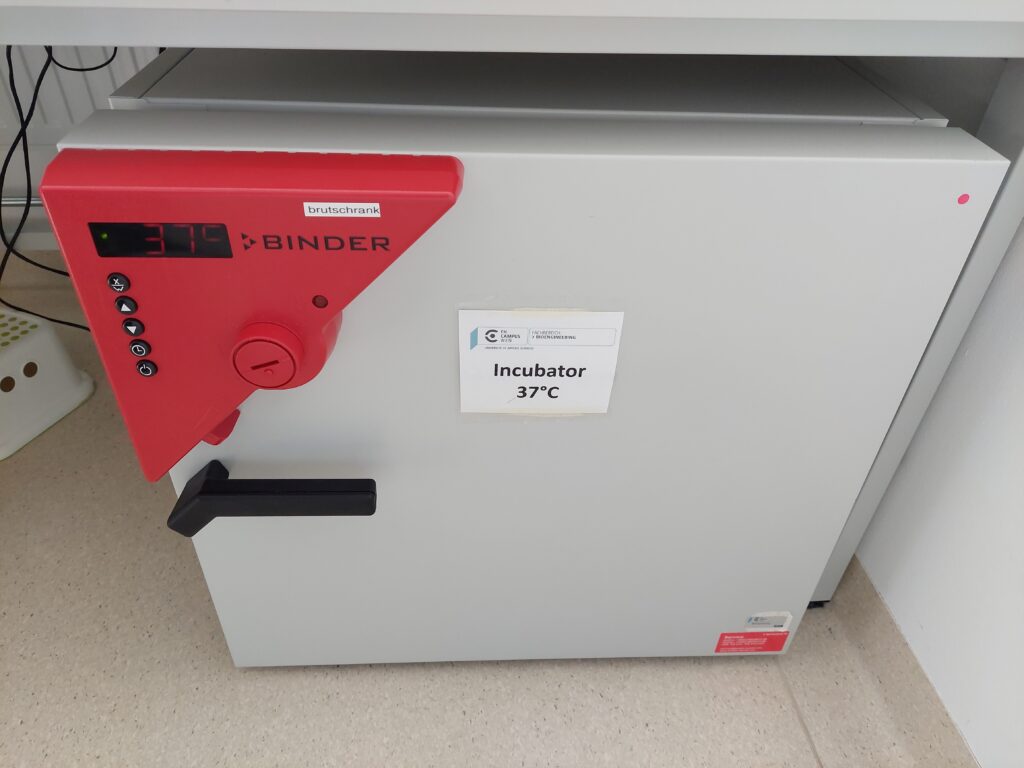
Brutschrank 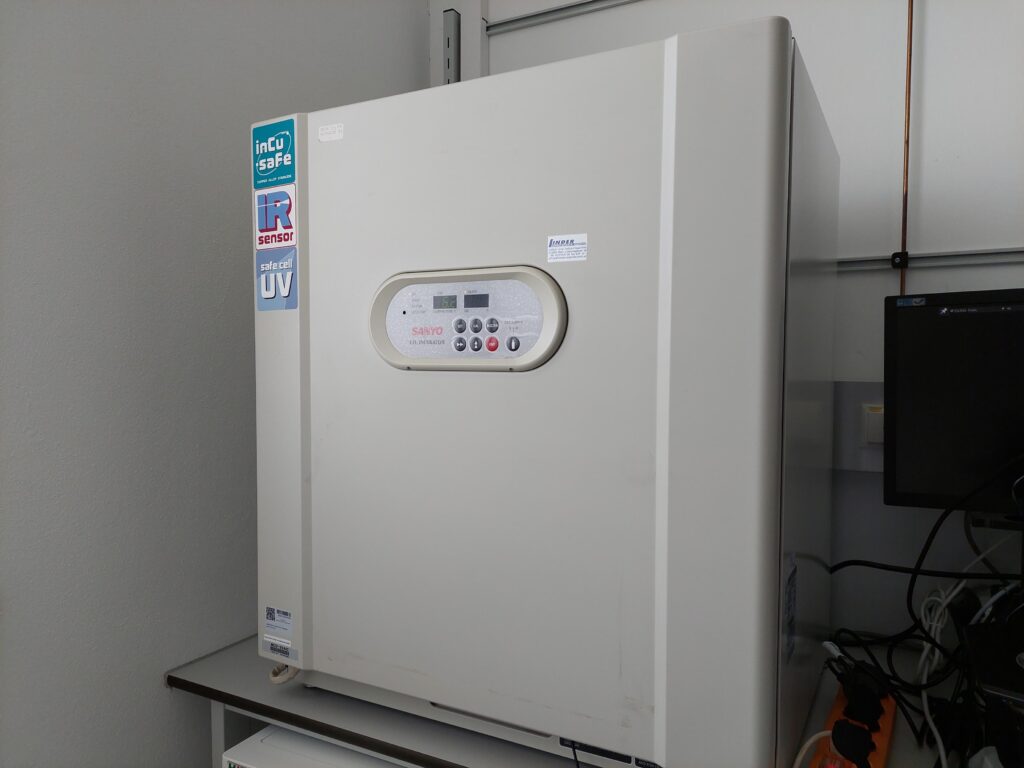
Zellkulturbrutschrank 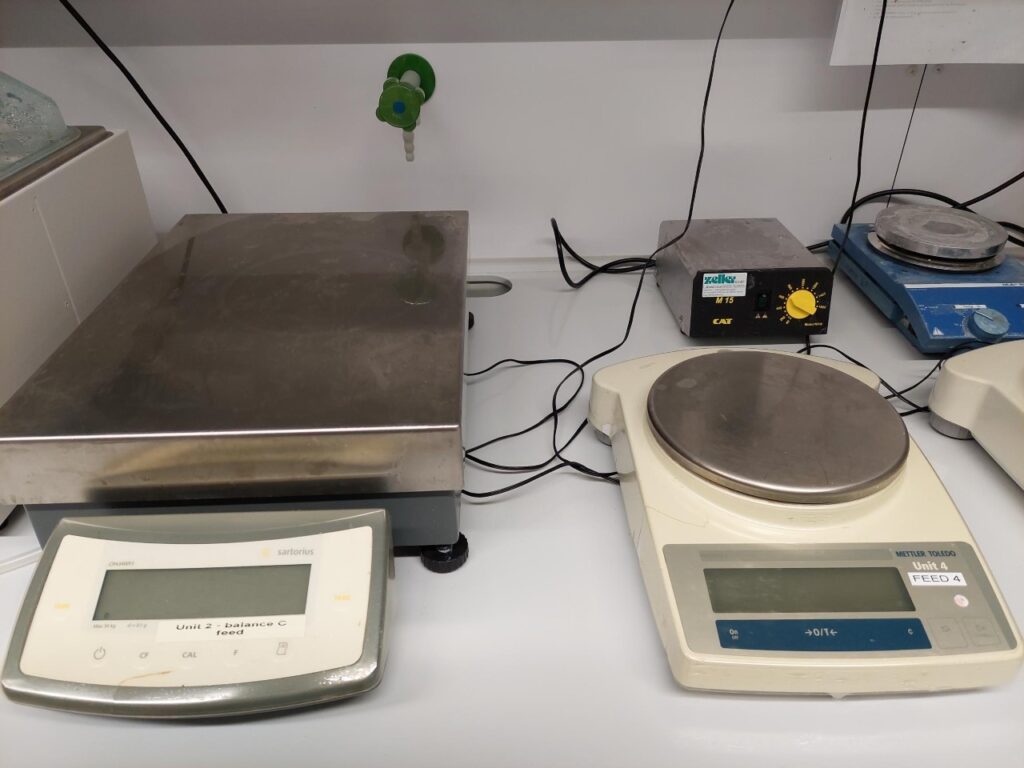
Waagen 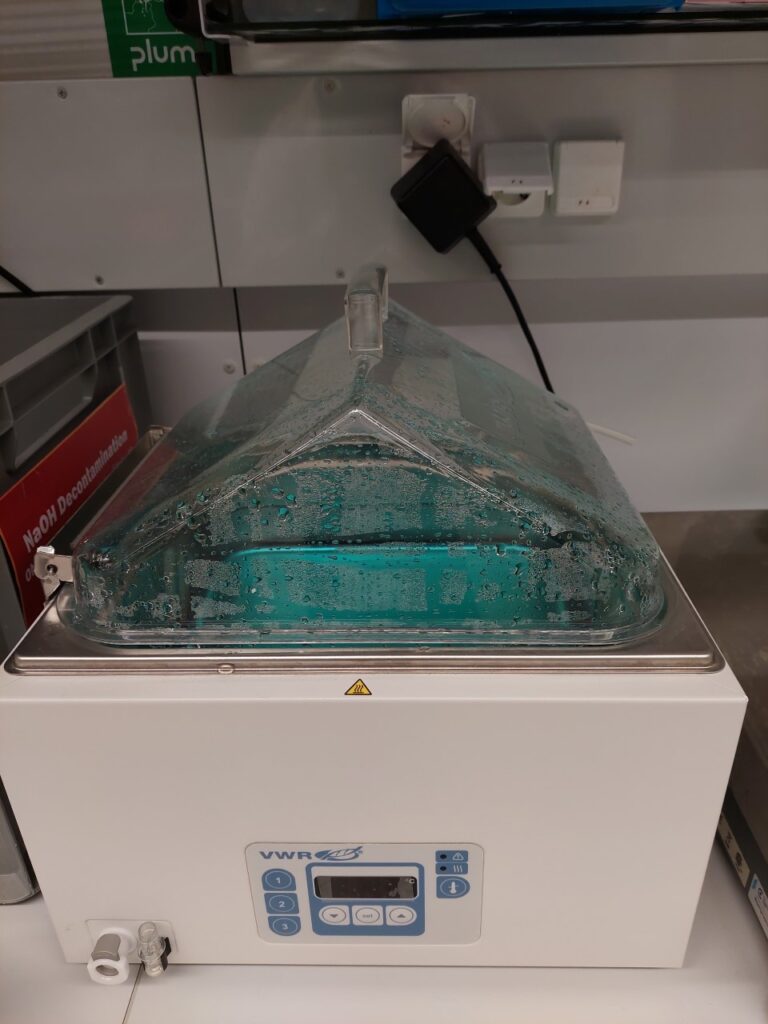
Wasserbad 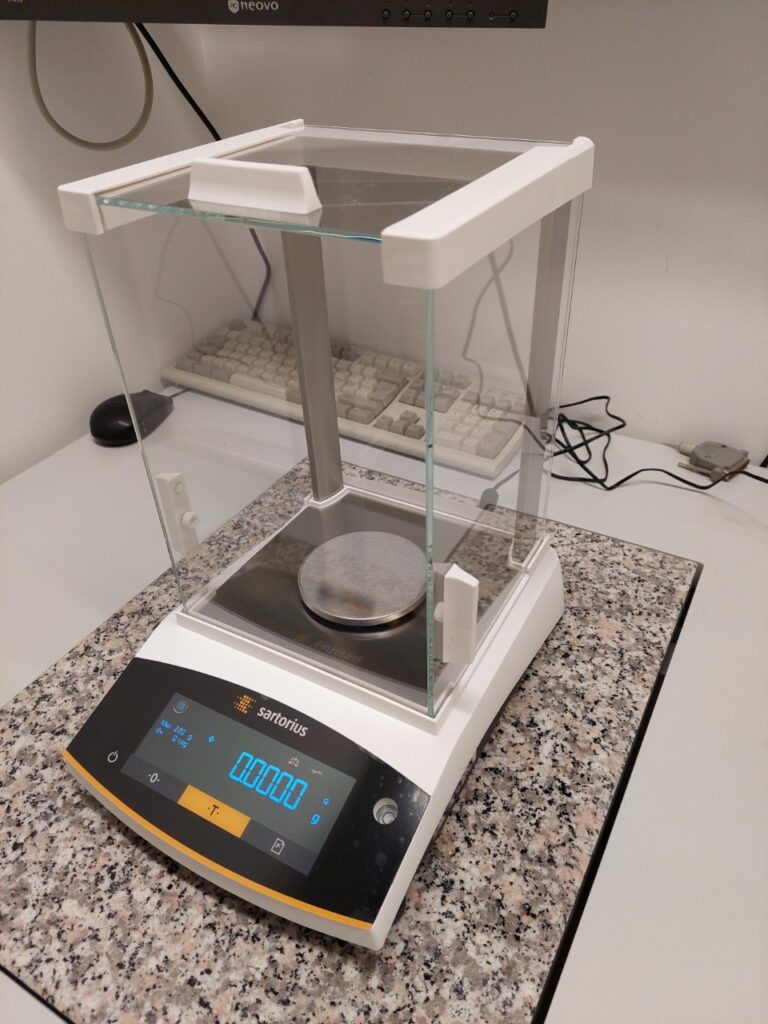
Analysenwaage 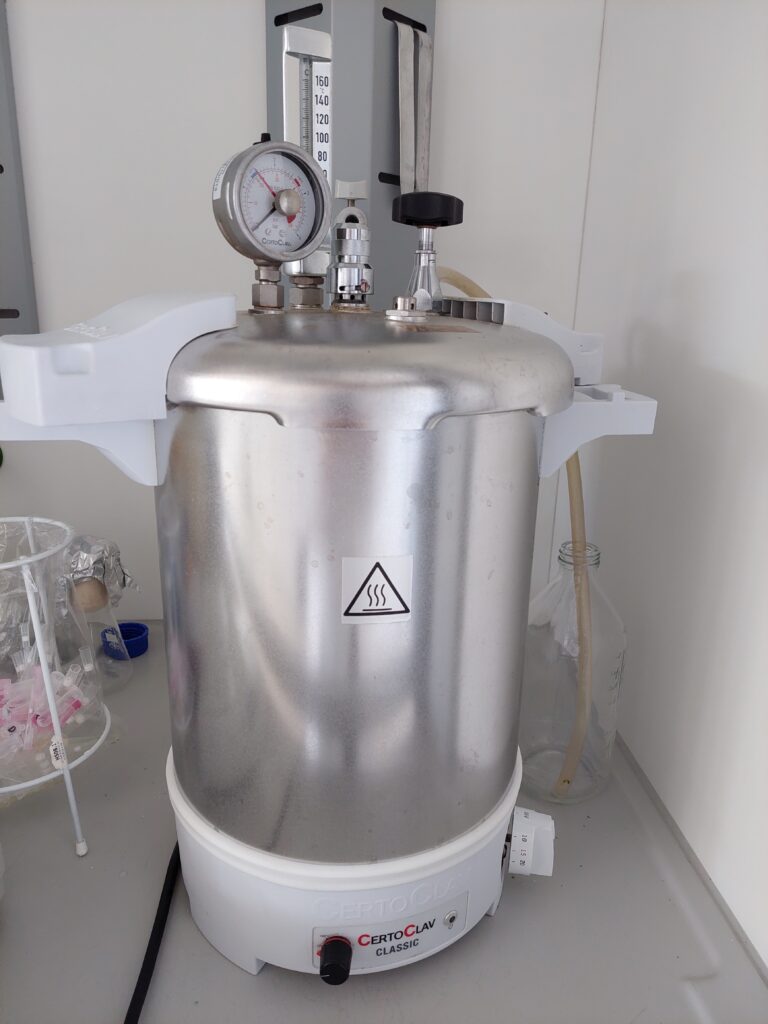
Tischautoklav 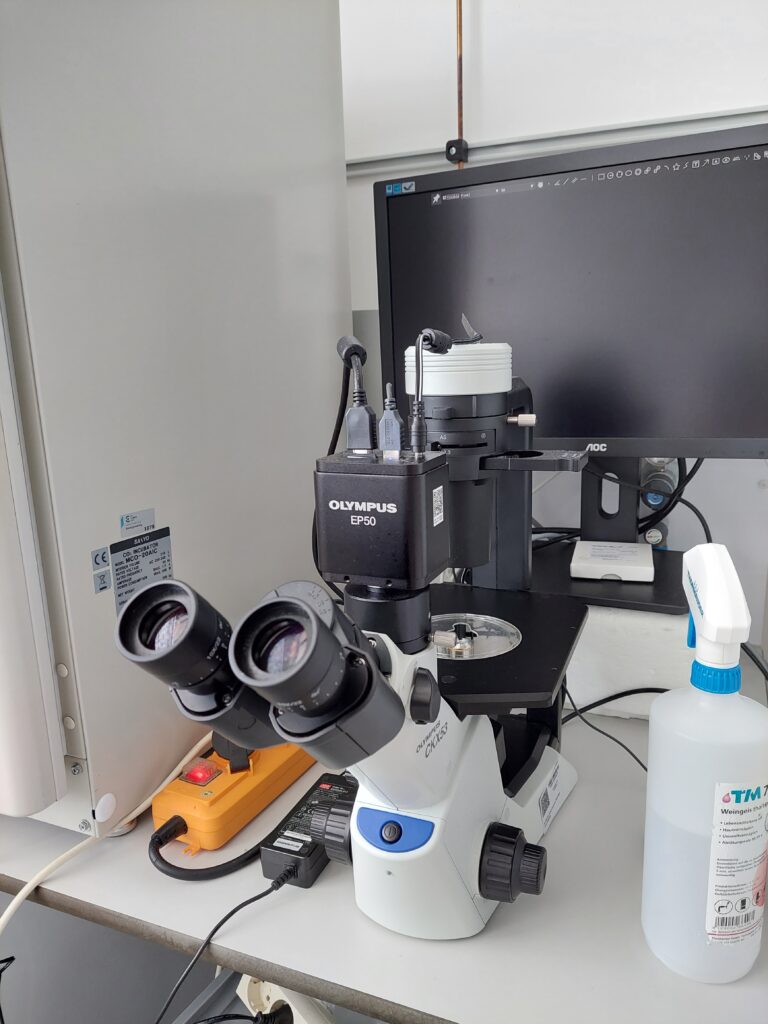
Zellkulturmikroskop 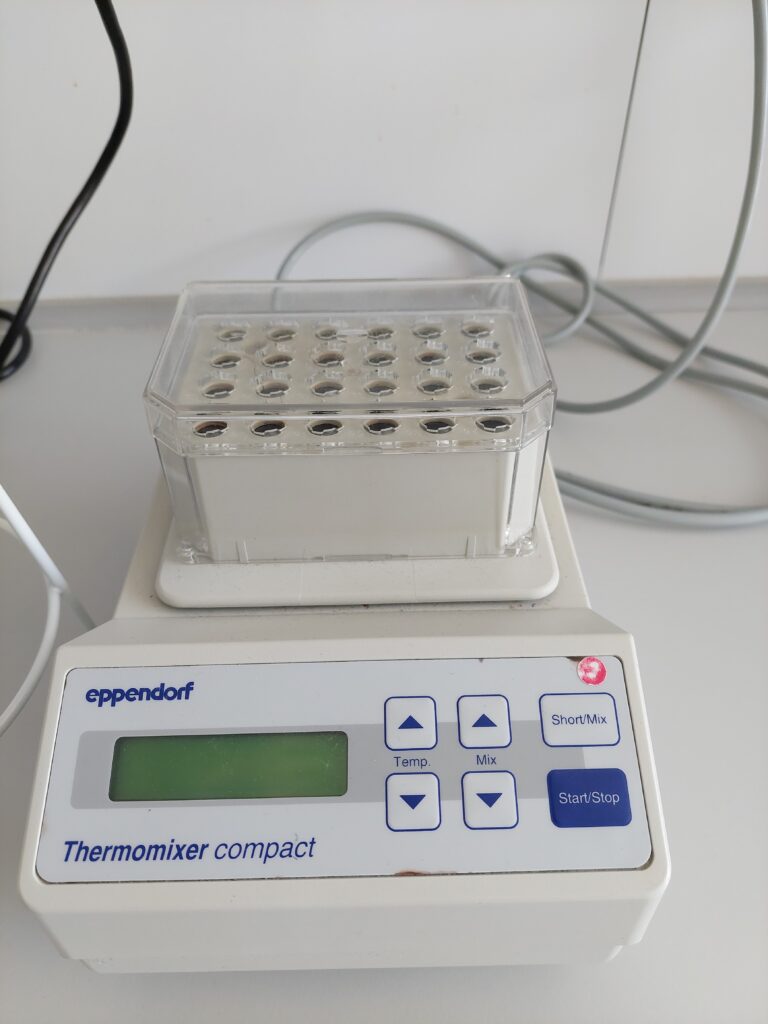
Thermoblock 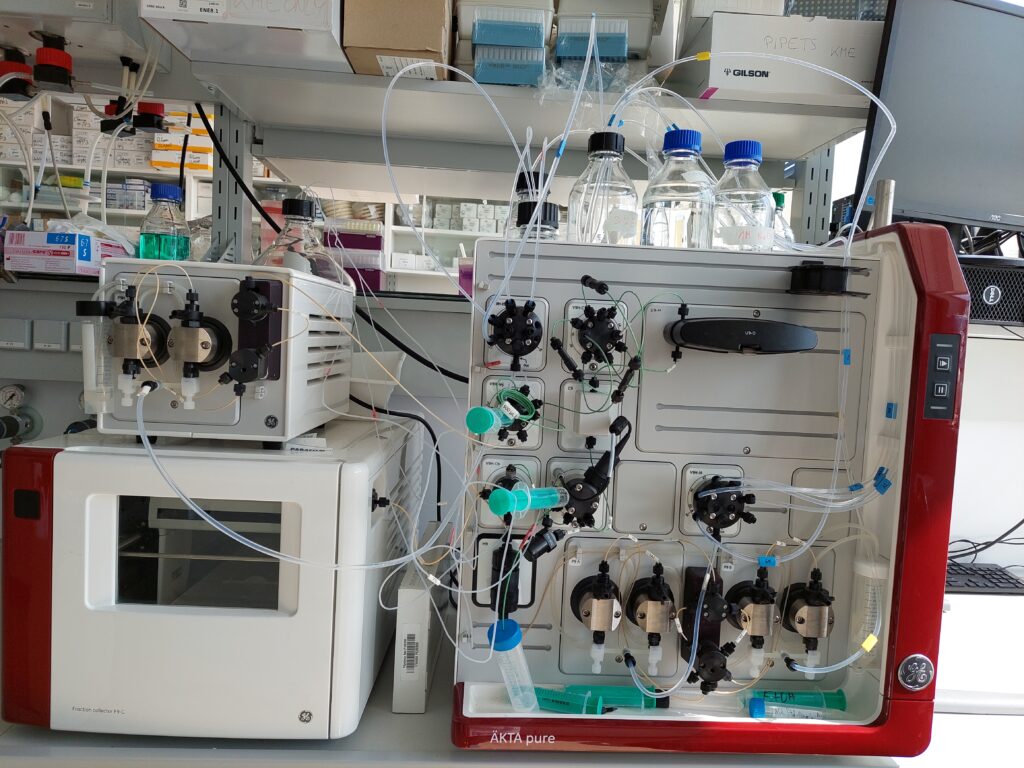
FPLC Anlage 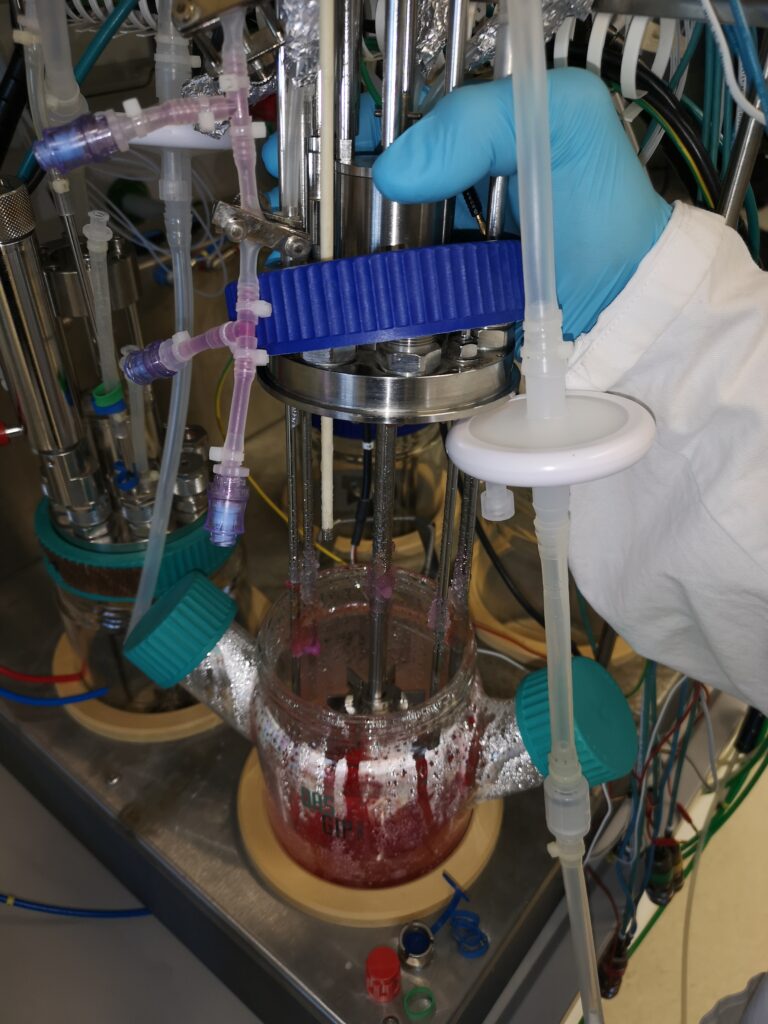
DasGip 4x Bioreaktoren 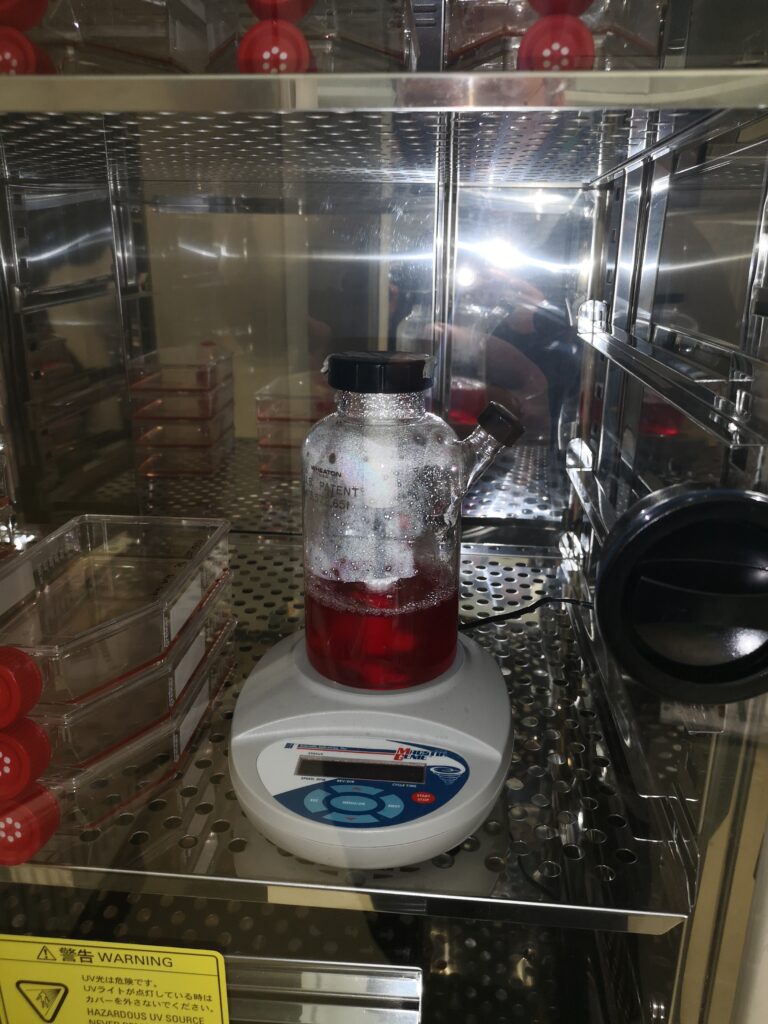
Spinner Kulturen in der Zellkultur 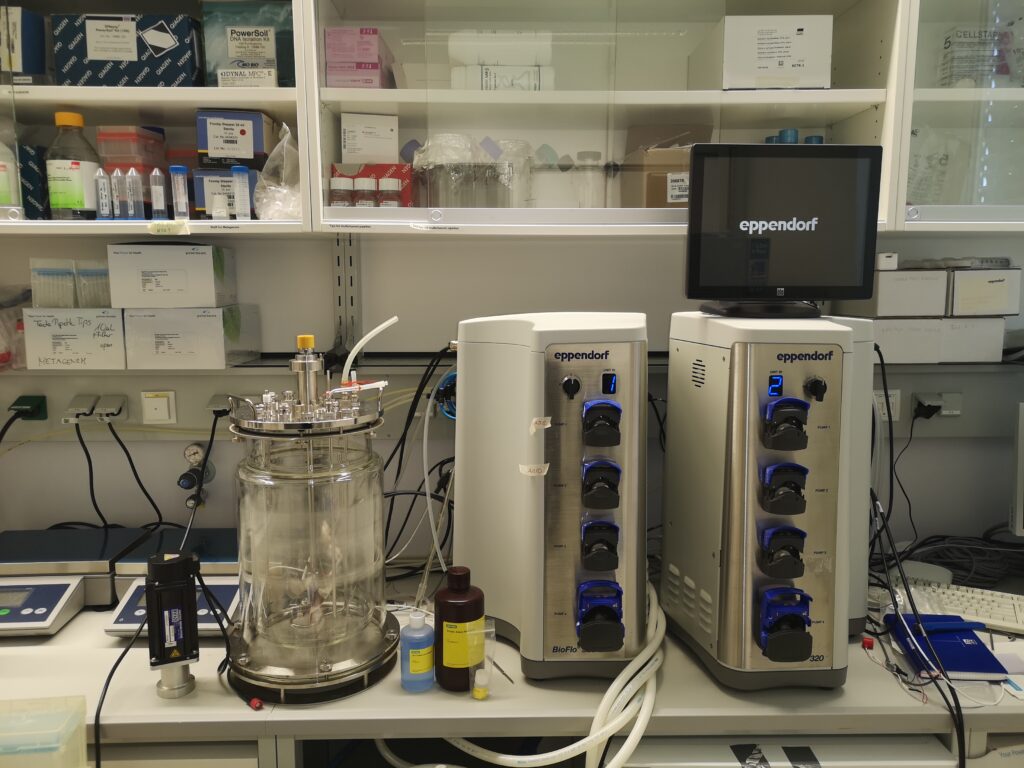
Zellkultur Bioreaktoren 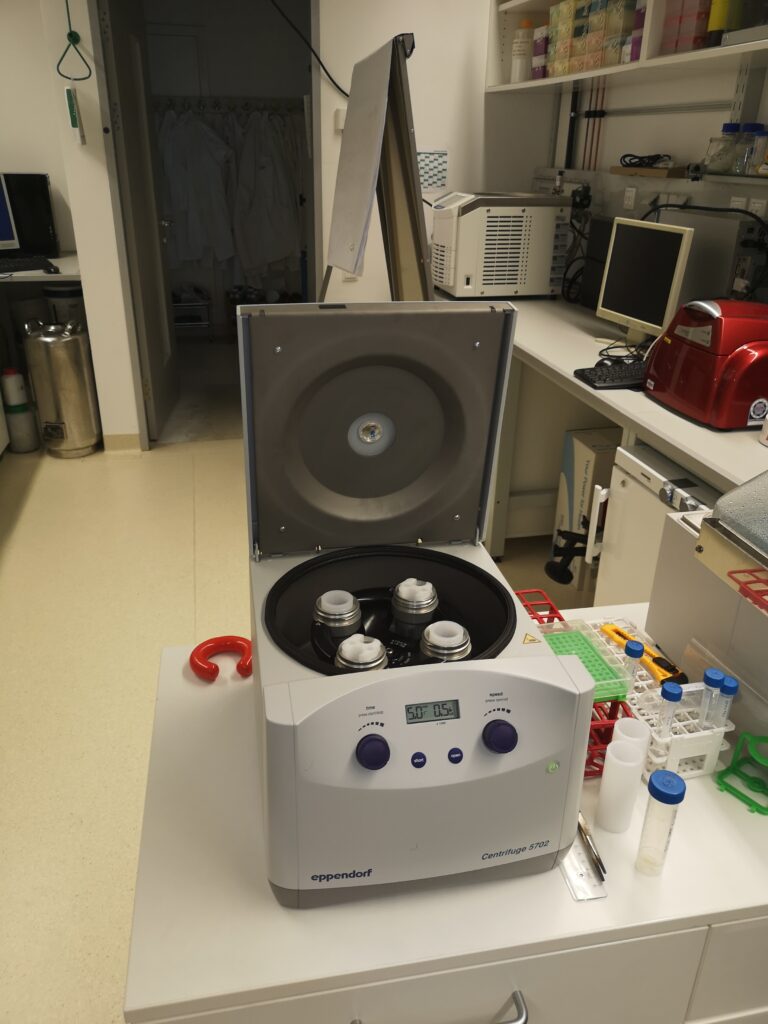
Zellkultur Zentrifuge 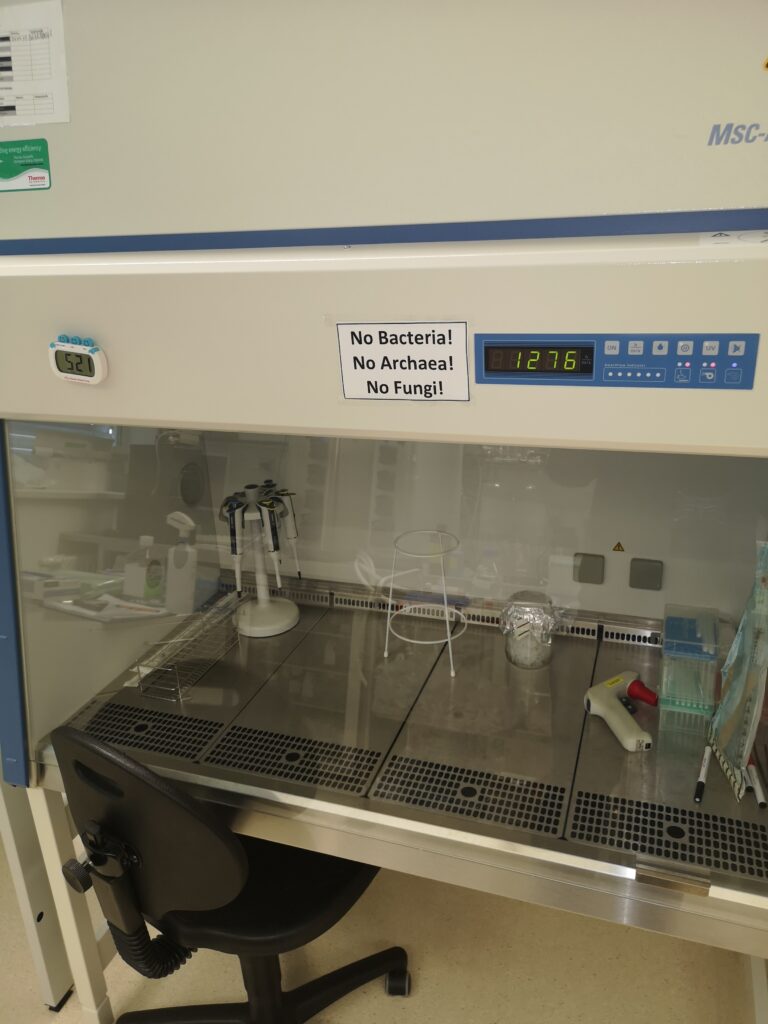
Lamina air flow in der Zellkultur 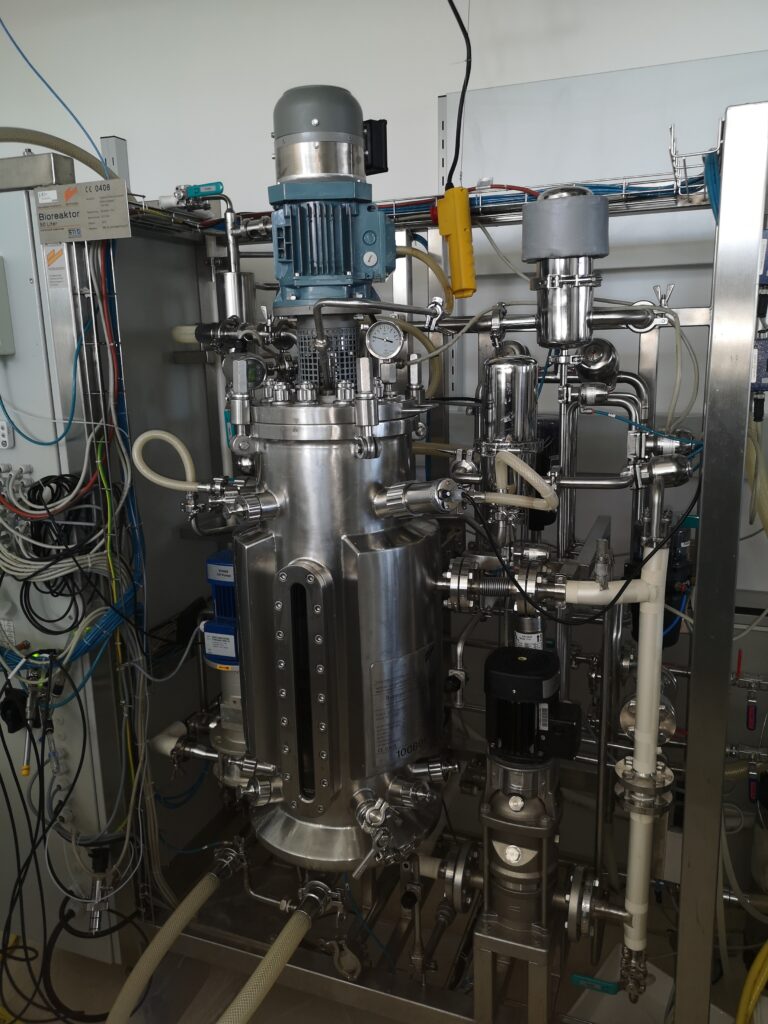
50l Bioreaktor 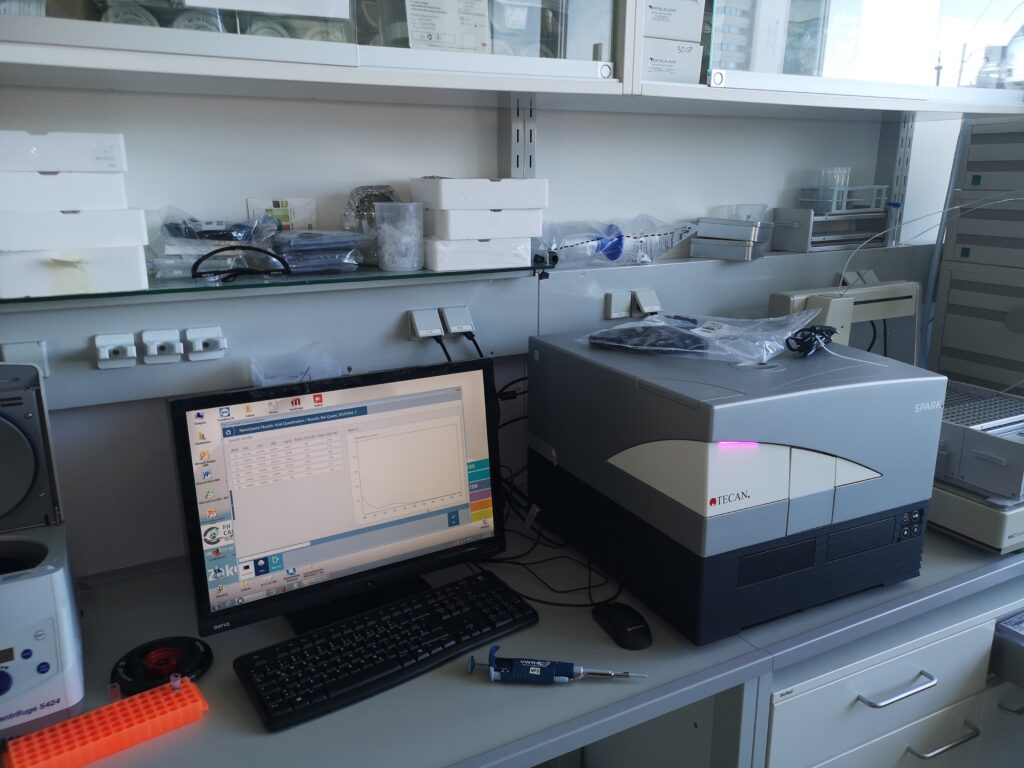
Tekan Multifunktions Gerät (Zellen zählen, Fluoreszenz und photometrie Messungen, …) 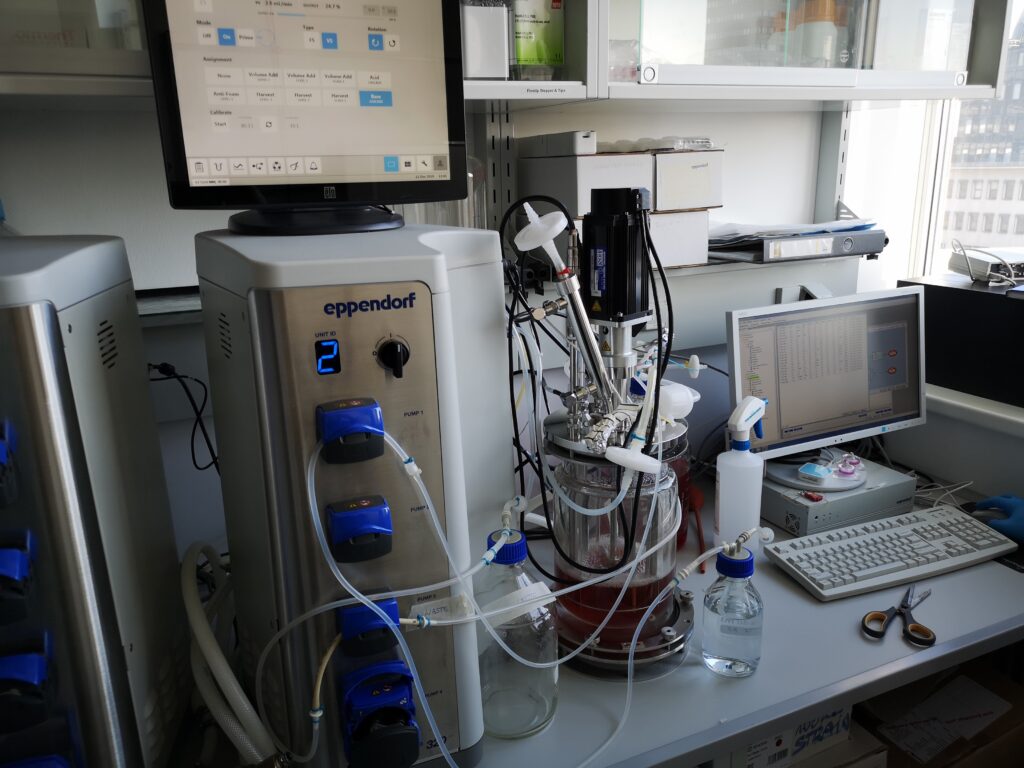
BioFlow im Einsatz 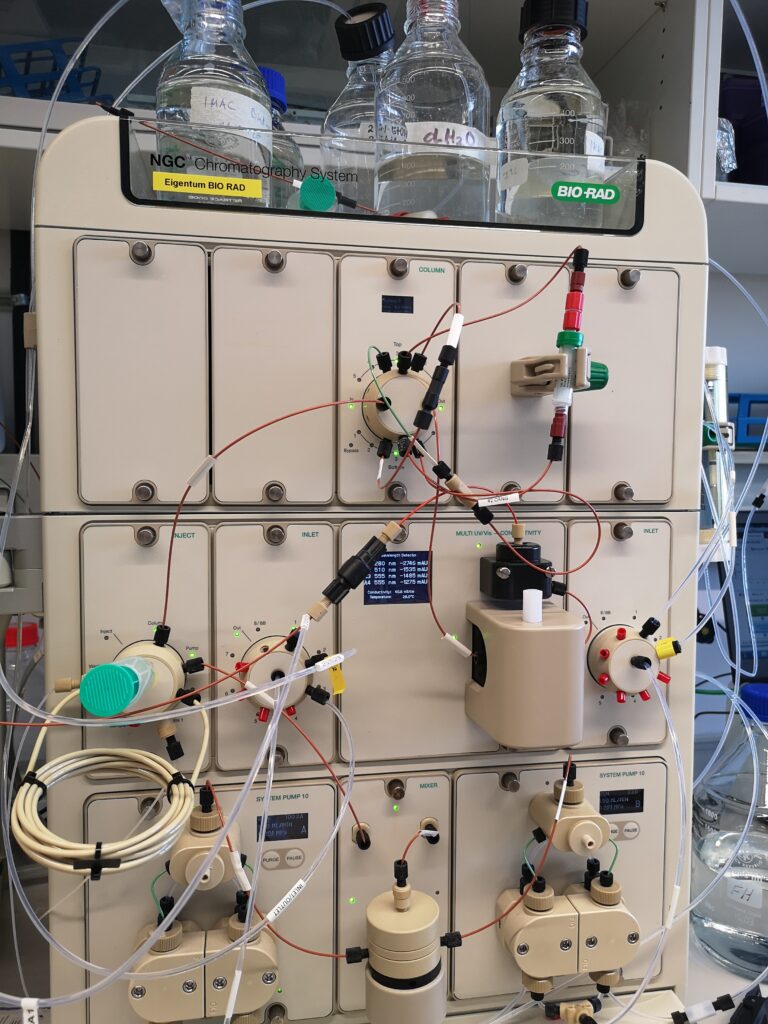
Wir haben mehrere BioRad FPLCs 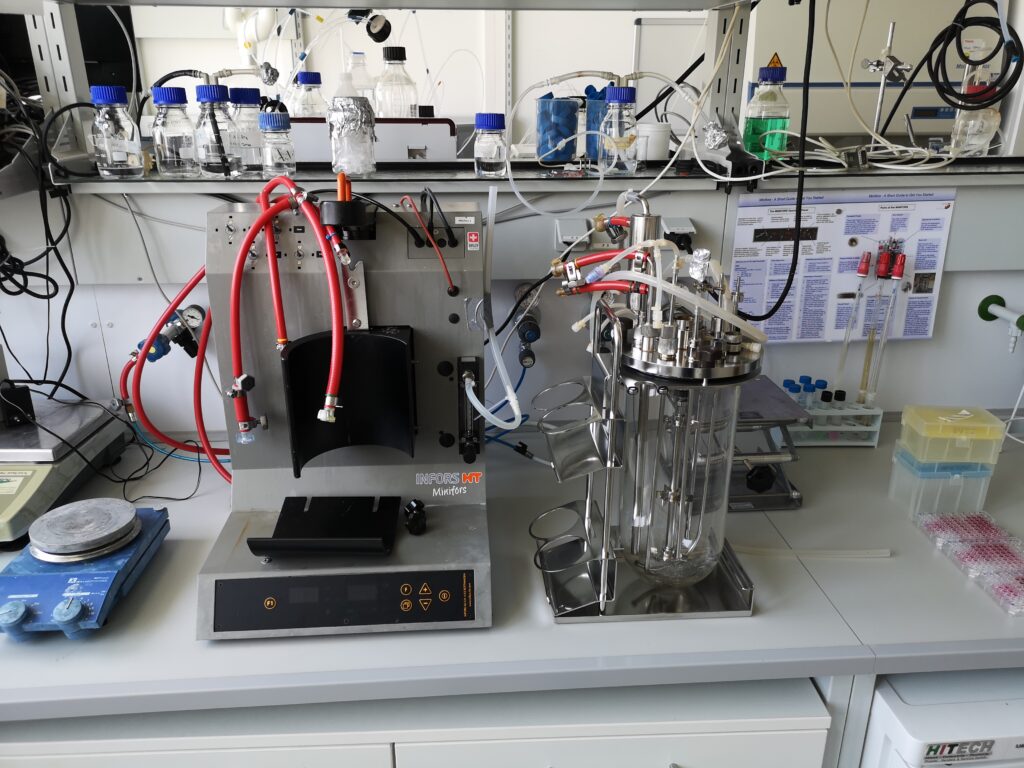
5l Bioreaktor 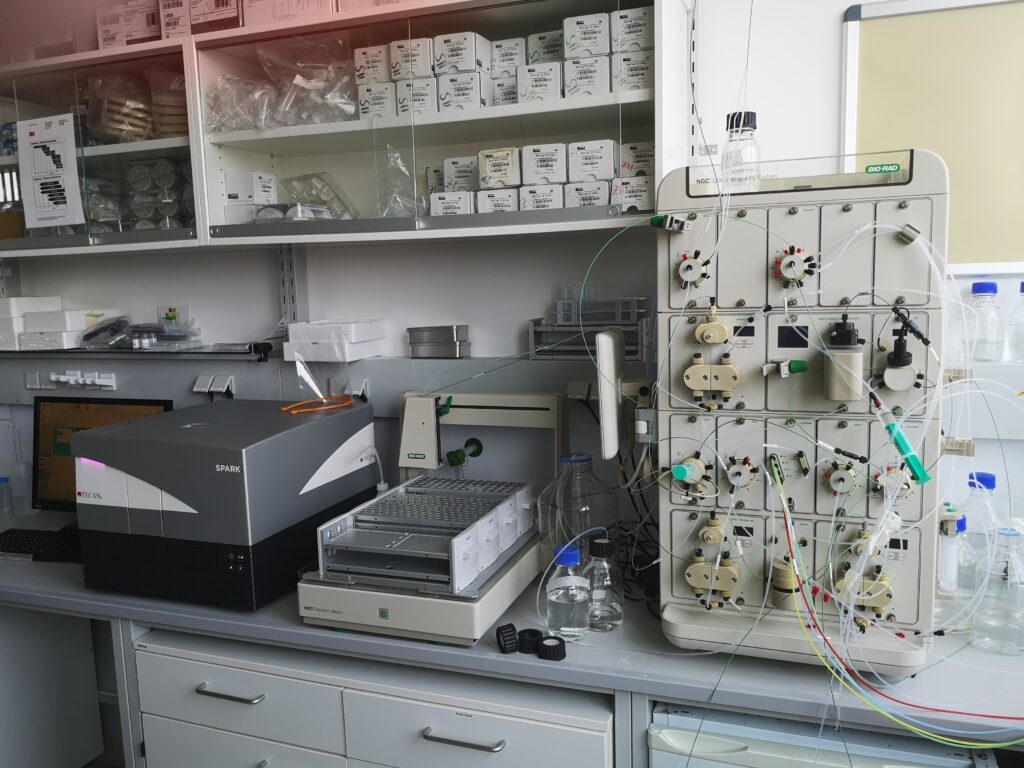
FPLC mit Fraktionssammler 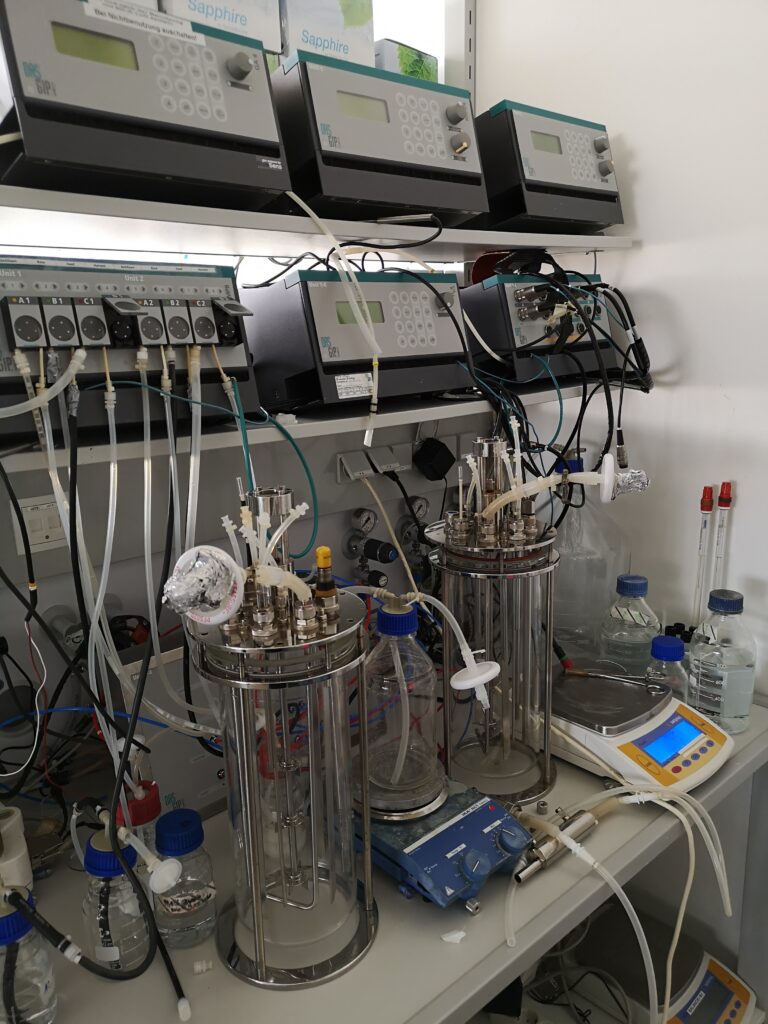
Weitere Bioreaktoren 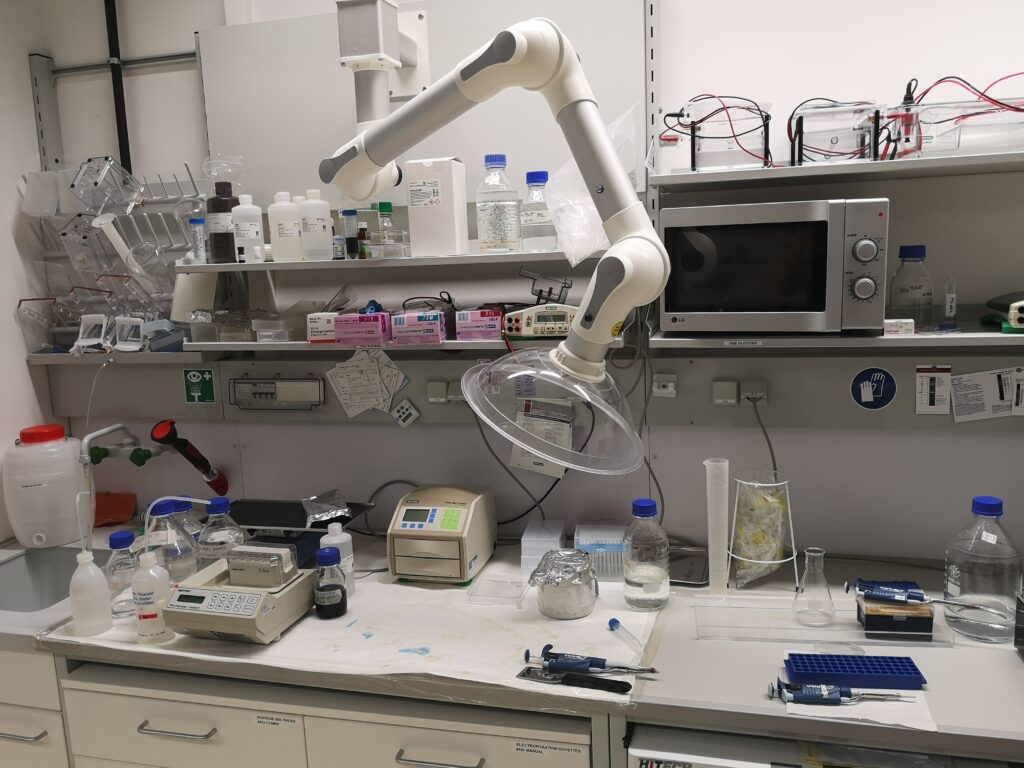
Elektrophroese (PAGE und Agarose) und WesternBlot 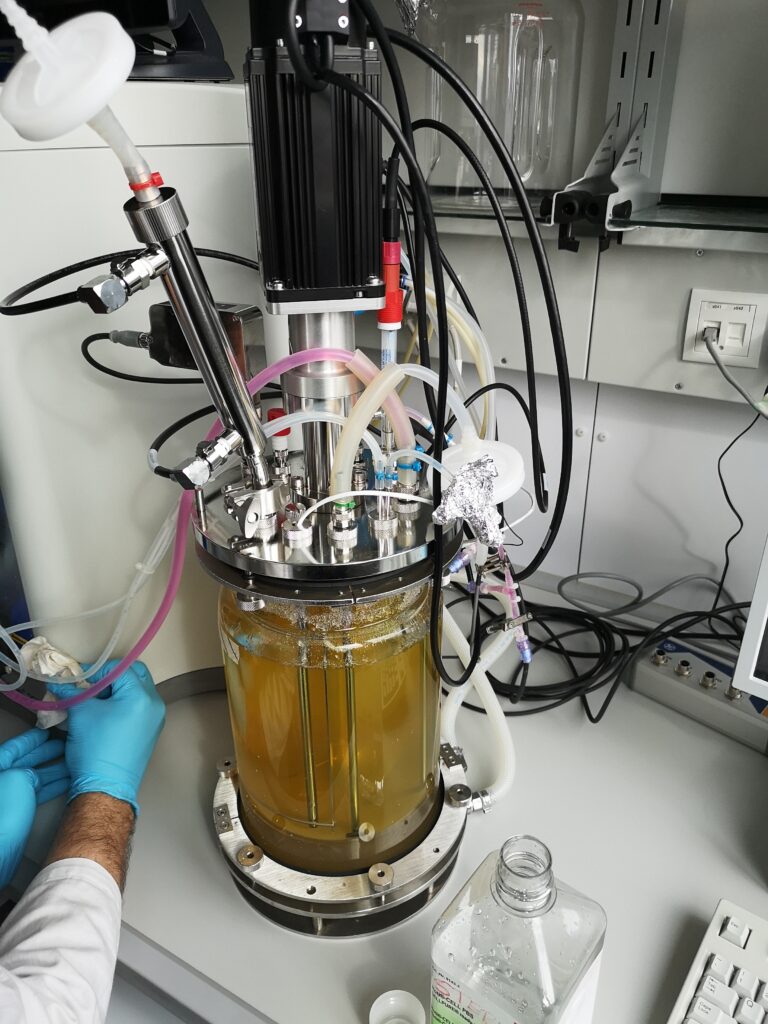
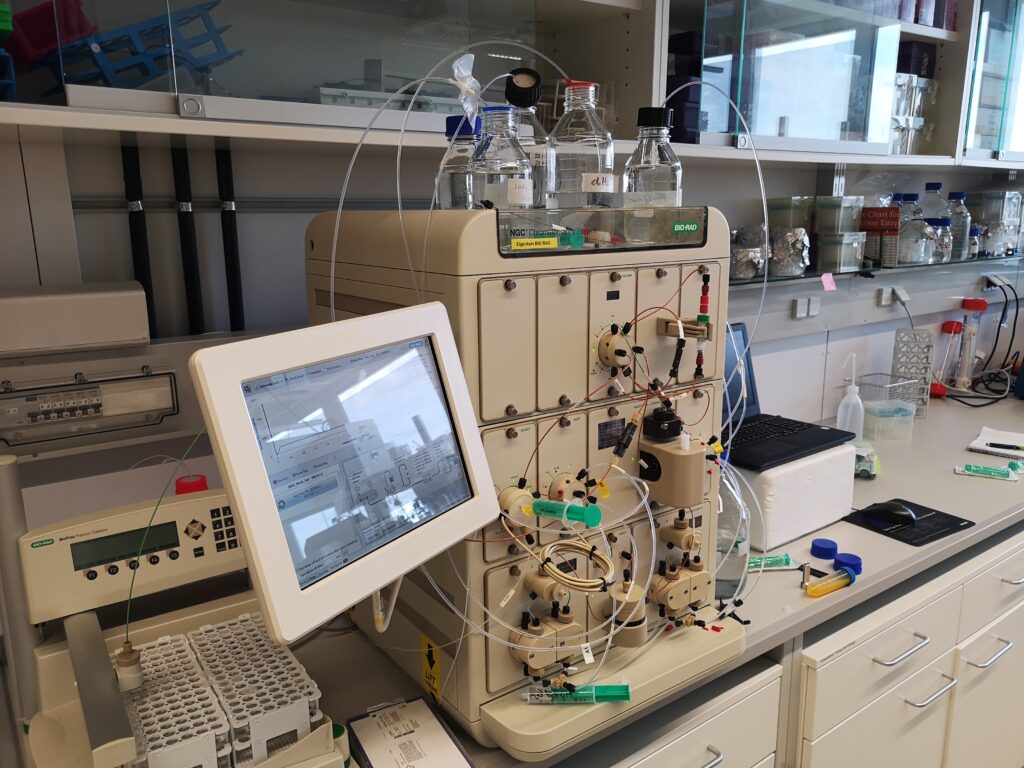
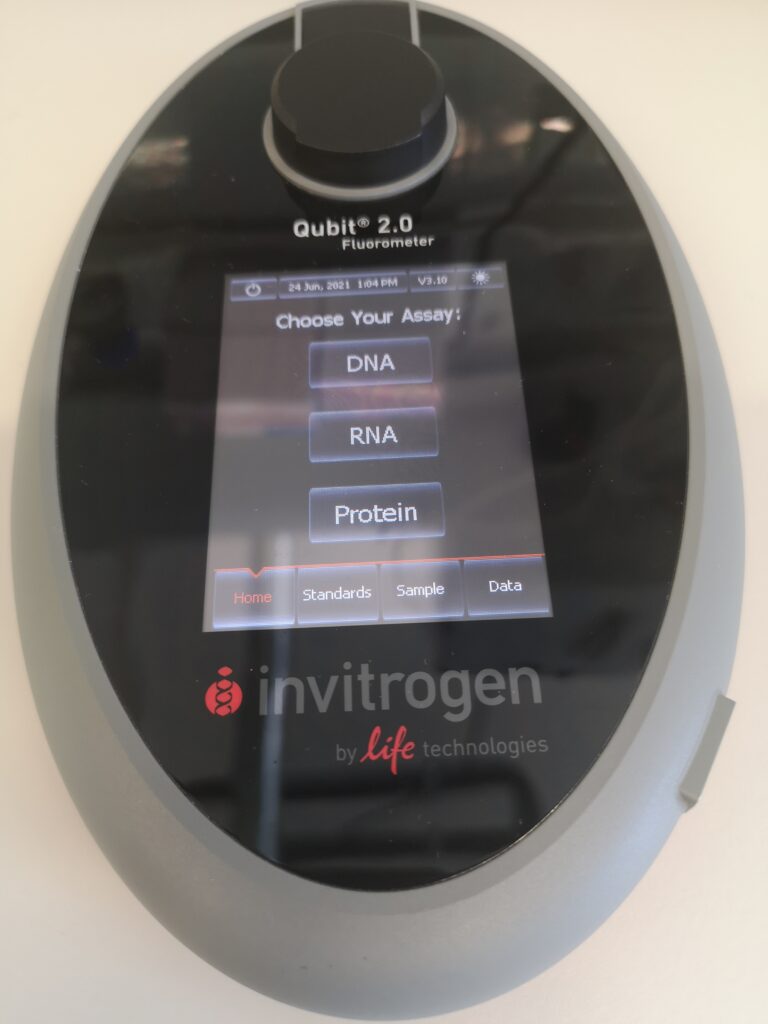
Ein paar Bilder von Zellen…
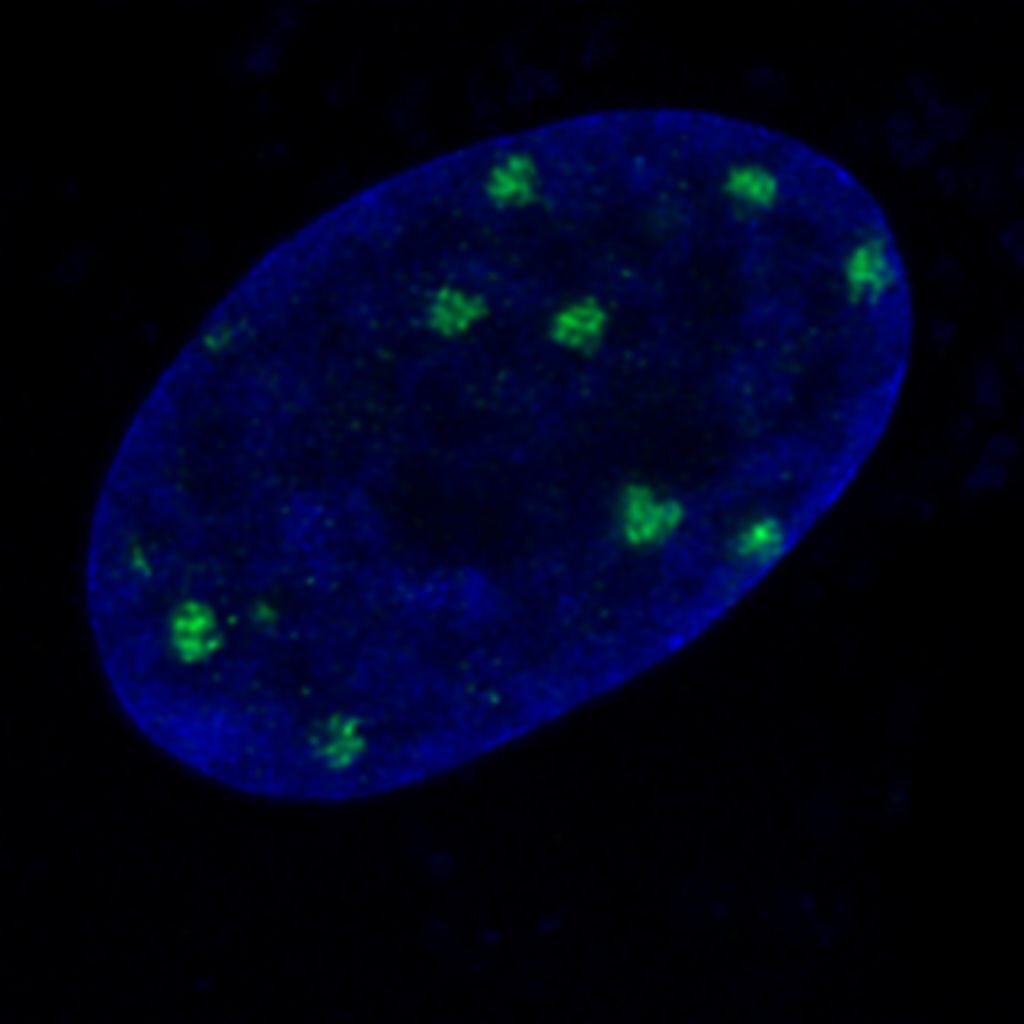
(Foto Dr. Markus Pasztorek) 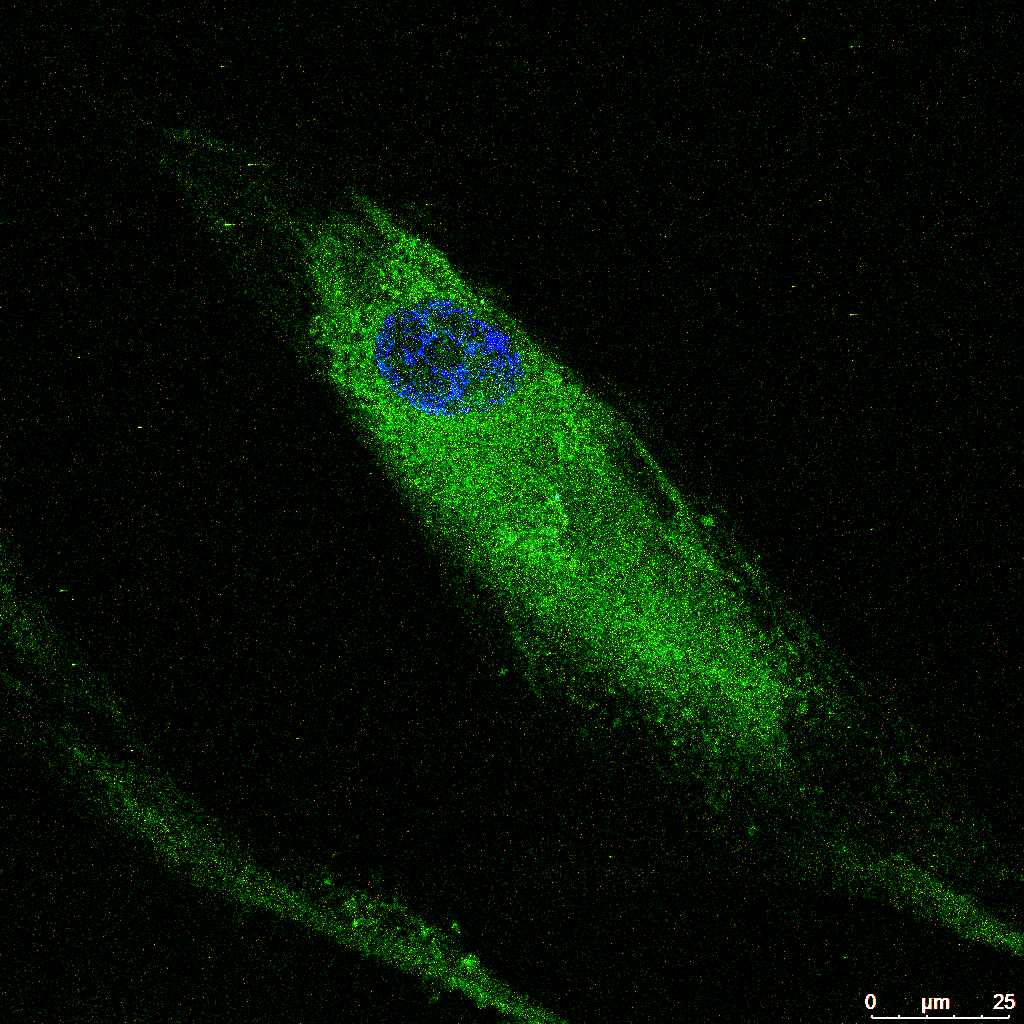
(Foto Dr. Markus Pasztorek) 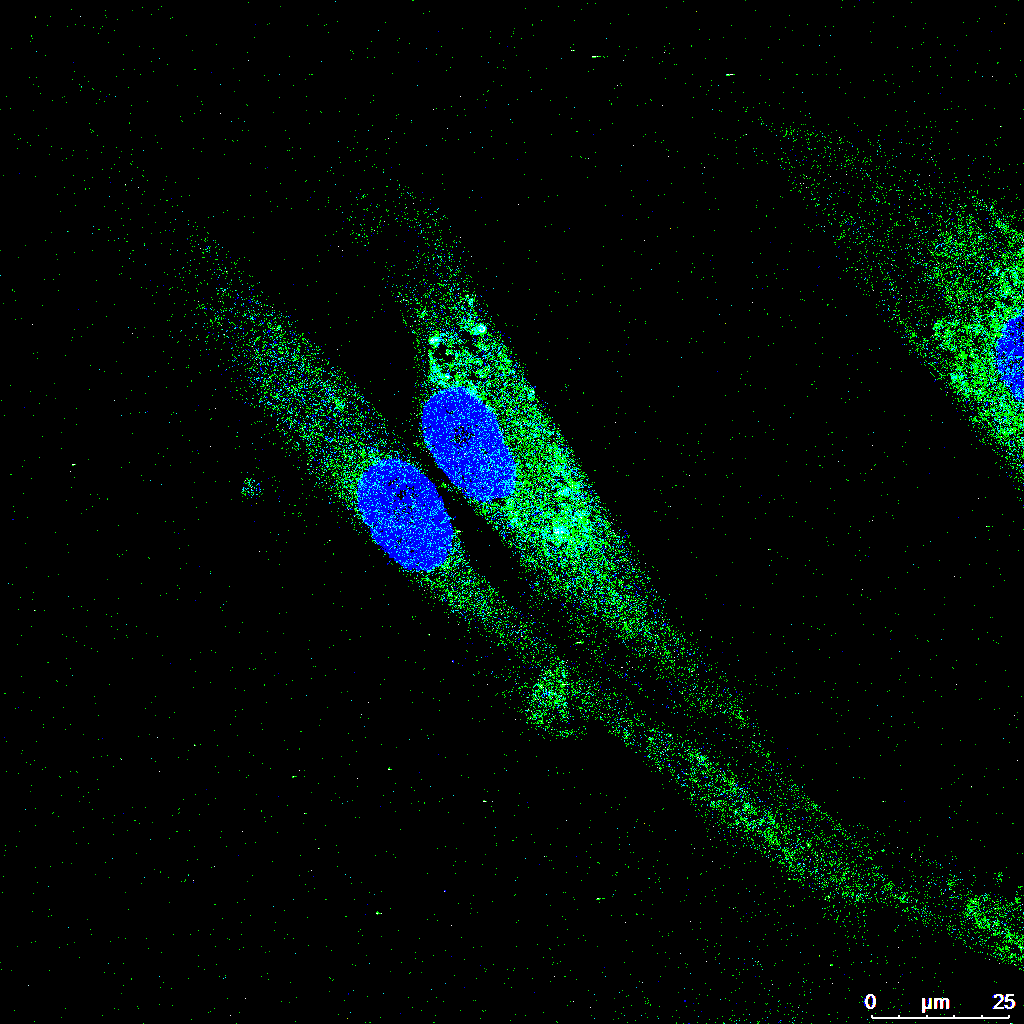
(Foto Dr. Markus Pasztorek) 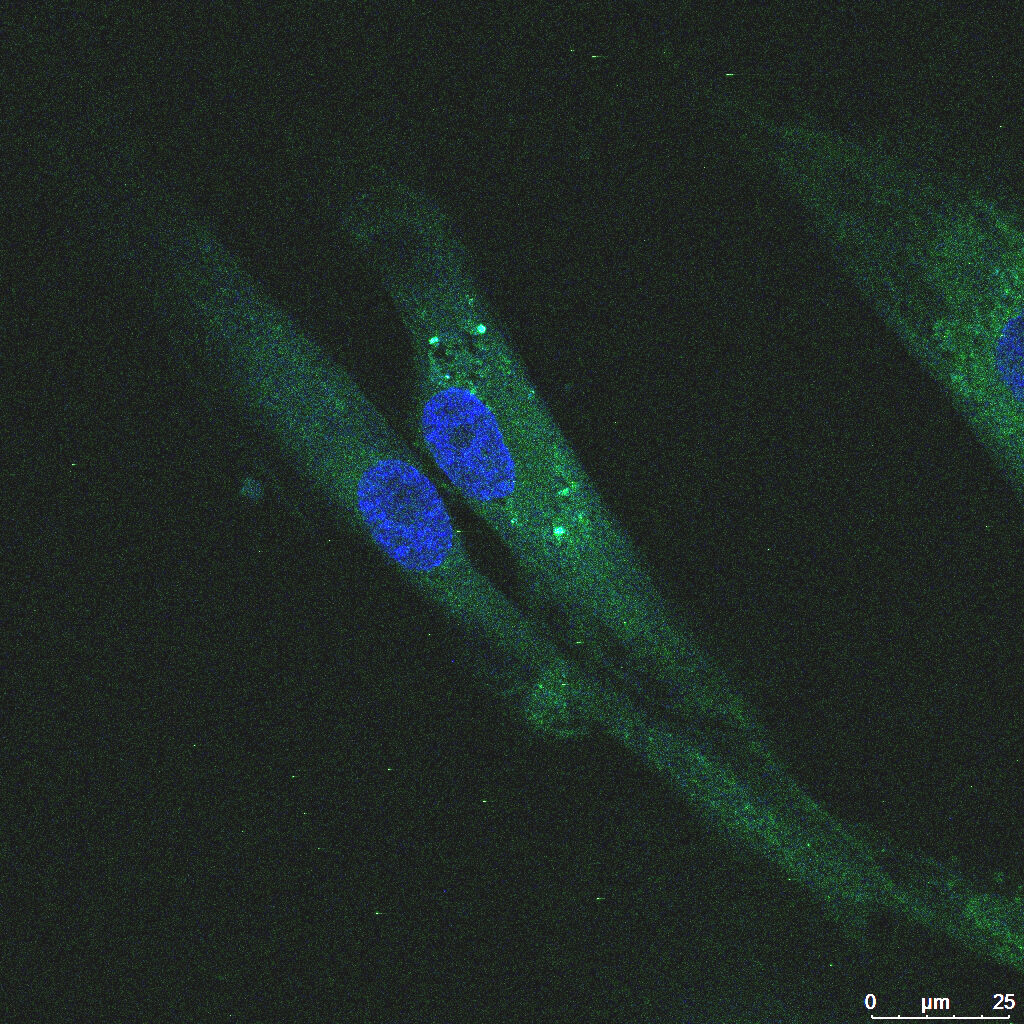
(Foto Dr. Markus Pasztorek) 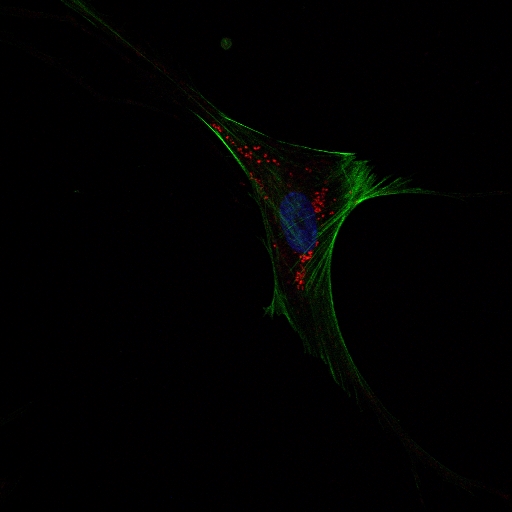
(Foto Dr. Markus Pasztorek) 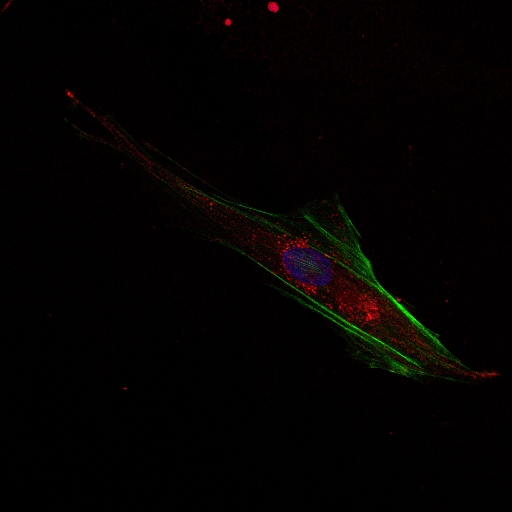
(Foto Dr. Markus Pasztorek) 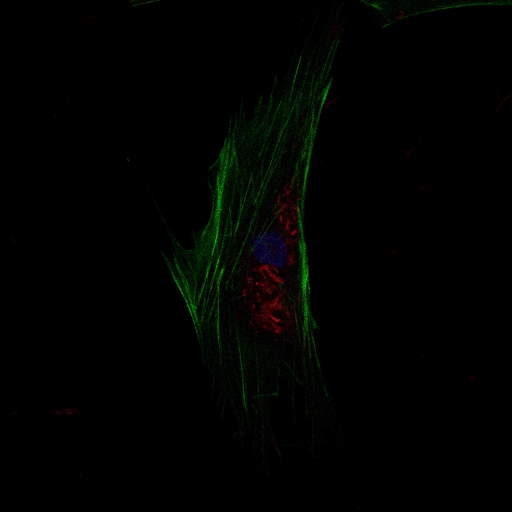
(Foto Dr. Markus Pasztorek)
Übungen…
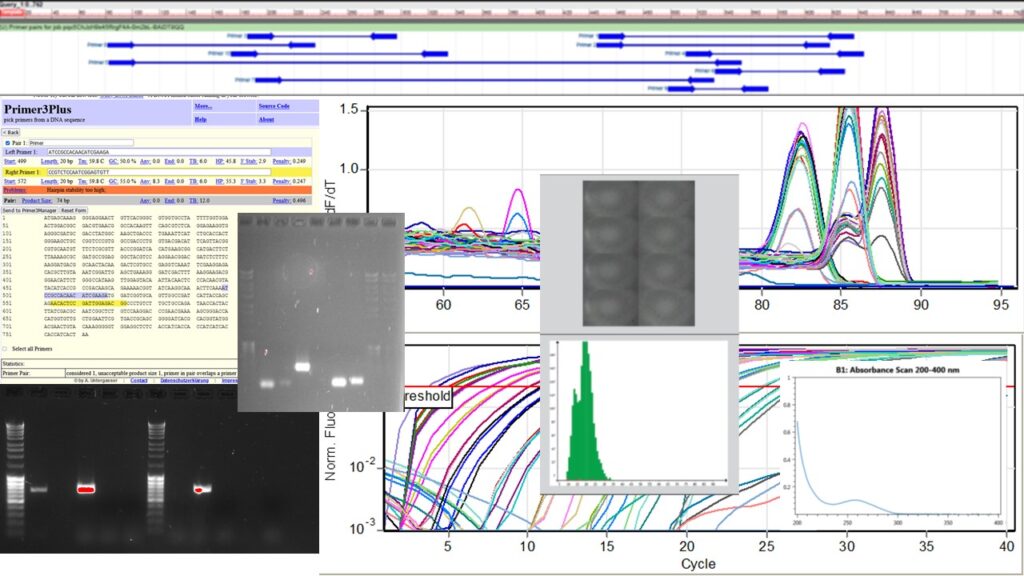
Molekularbiologie Übungen Master BVT:
- Kultivierung von Säugetier Zellen (CRFK)
- Transfektion von Säugetier Zellen
- Fluoreszenz Messungen
- DNA-Konzentration UV/Vis
- PCR
- Mykoplasmen Testungen
- qPCR
Bioanalytik Übungen
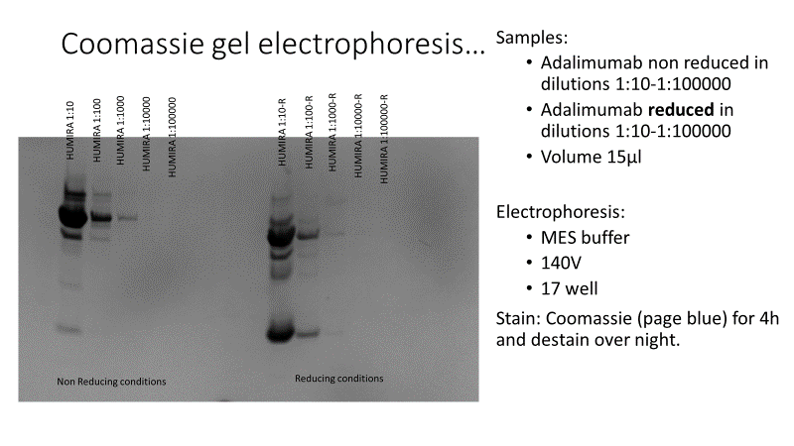
Simuliert wird eine Finale Charakterisierung eines rekombinanten Antikörpers mittels Proteinbestimmungen (BCA, DC, Bradford, UV280), ELISA, Westernblot und Coomassie gefärbte Elektrophorese…
